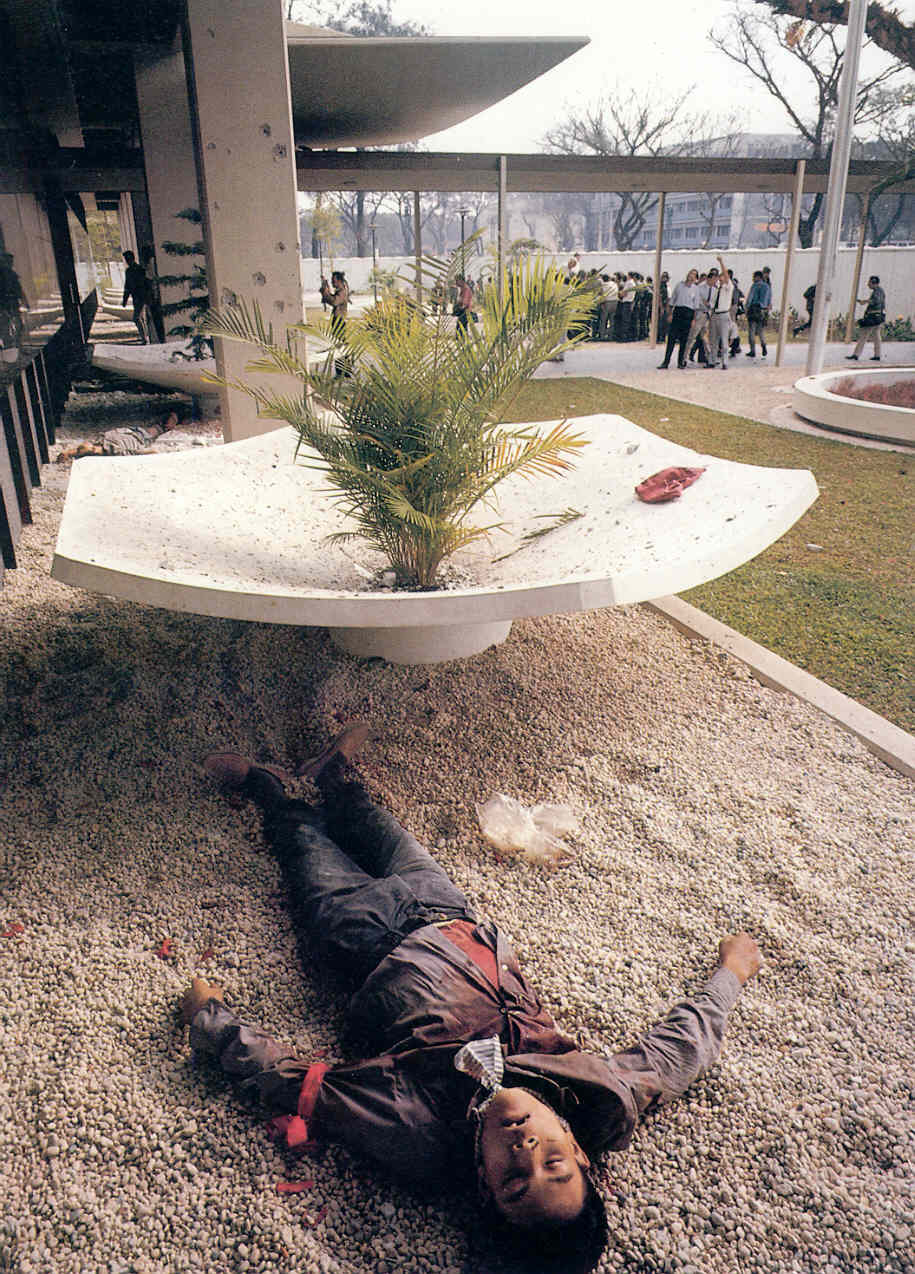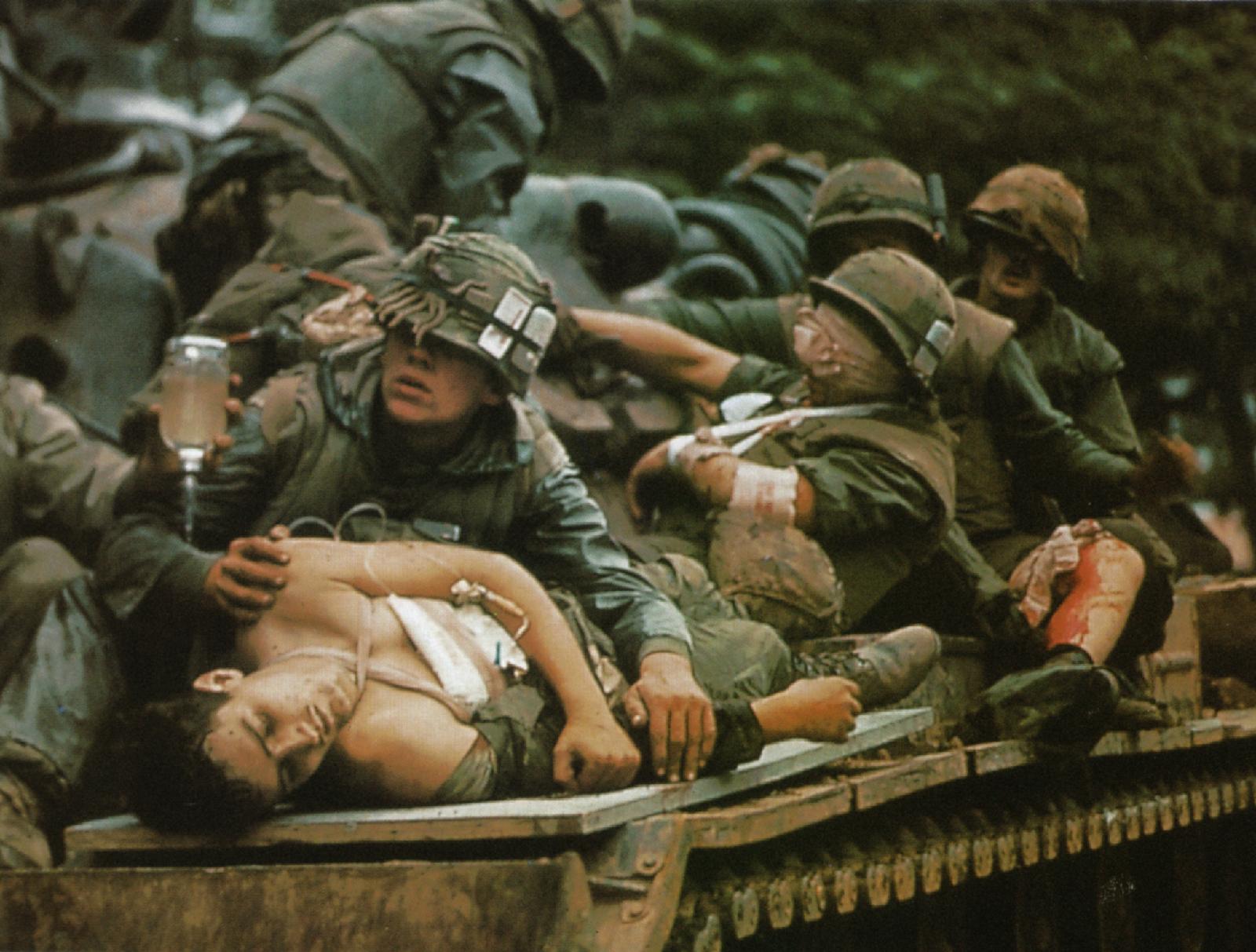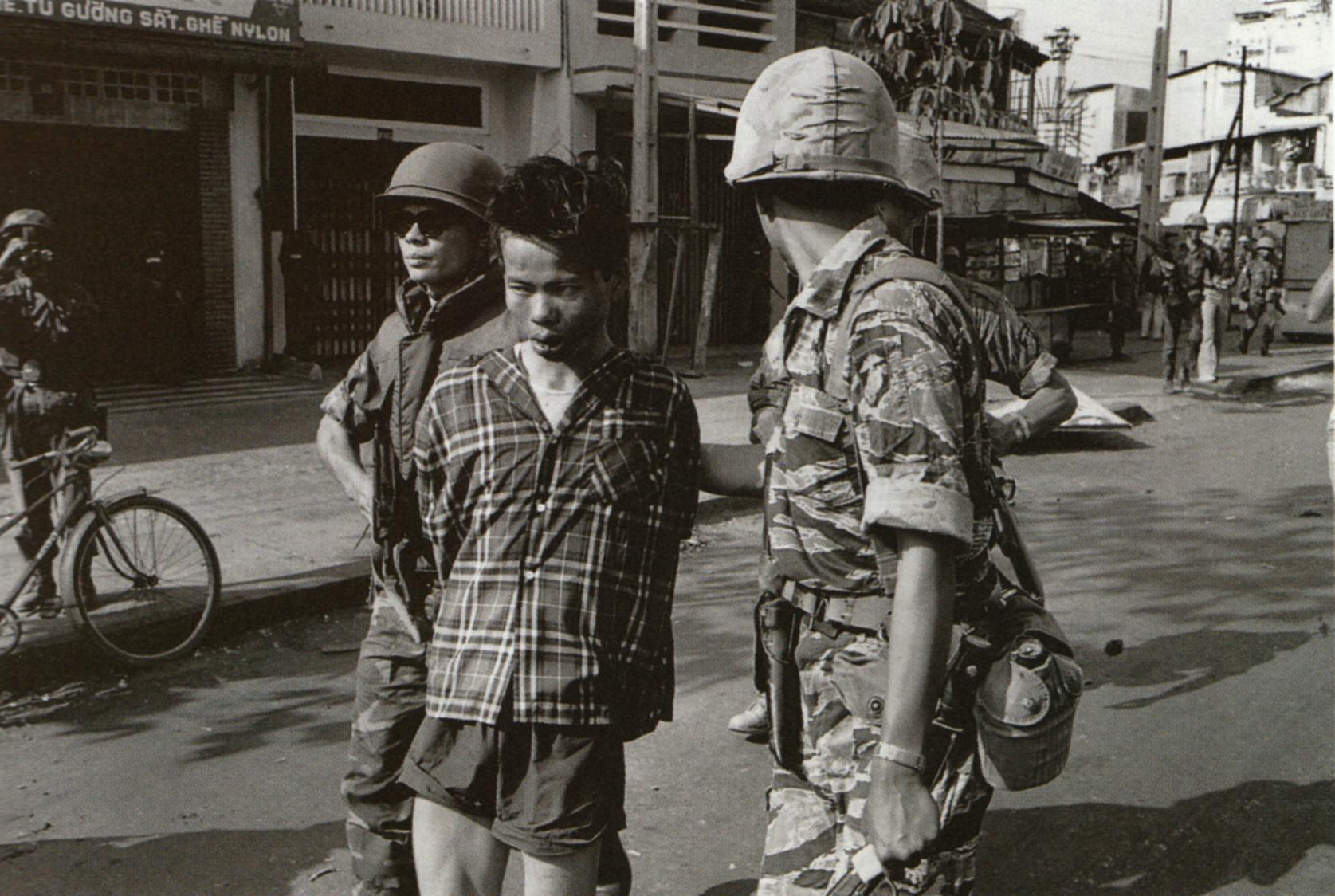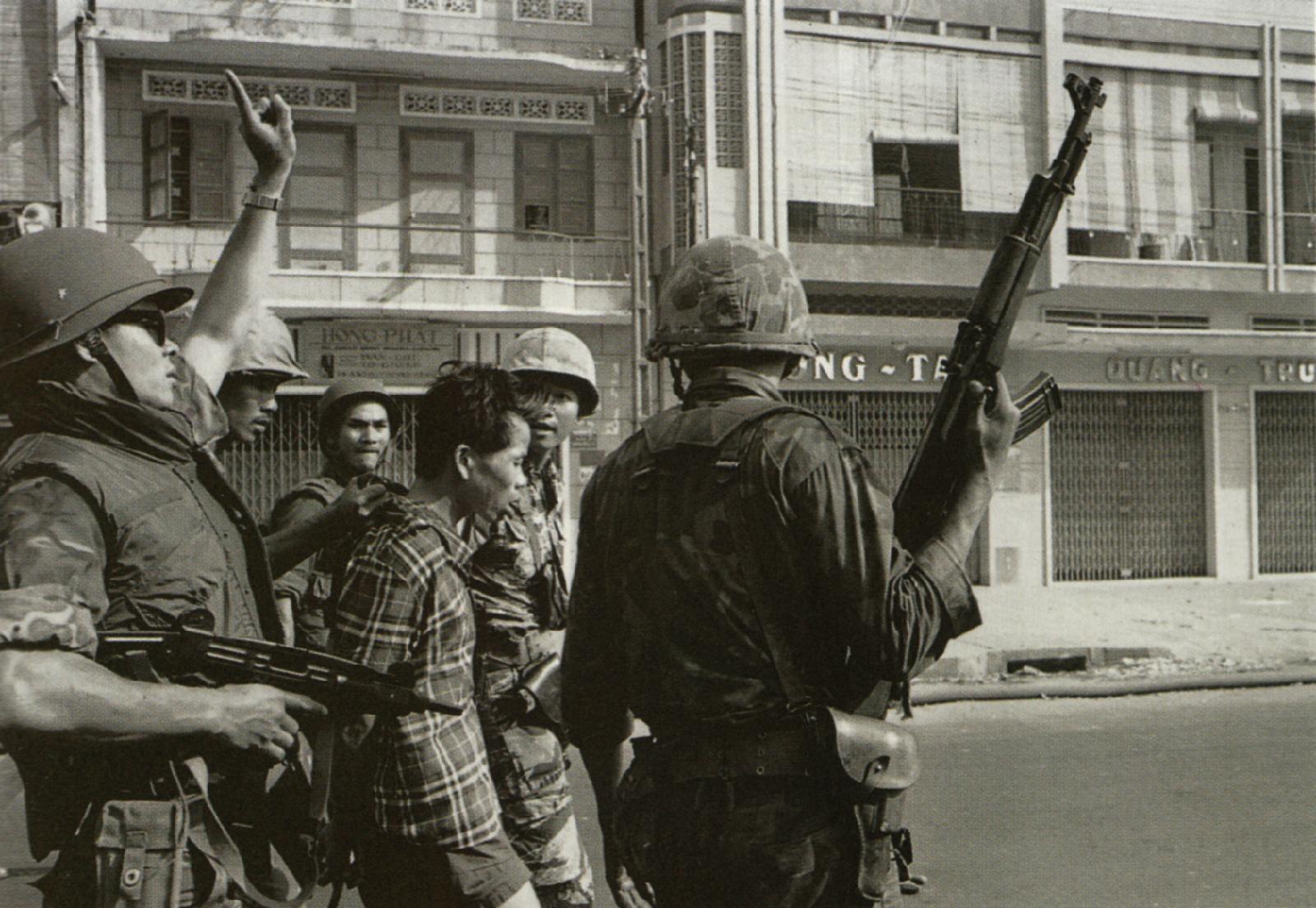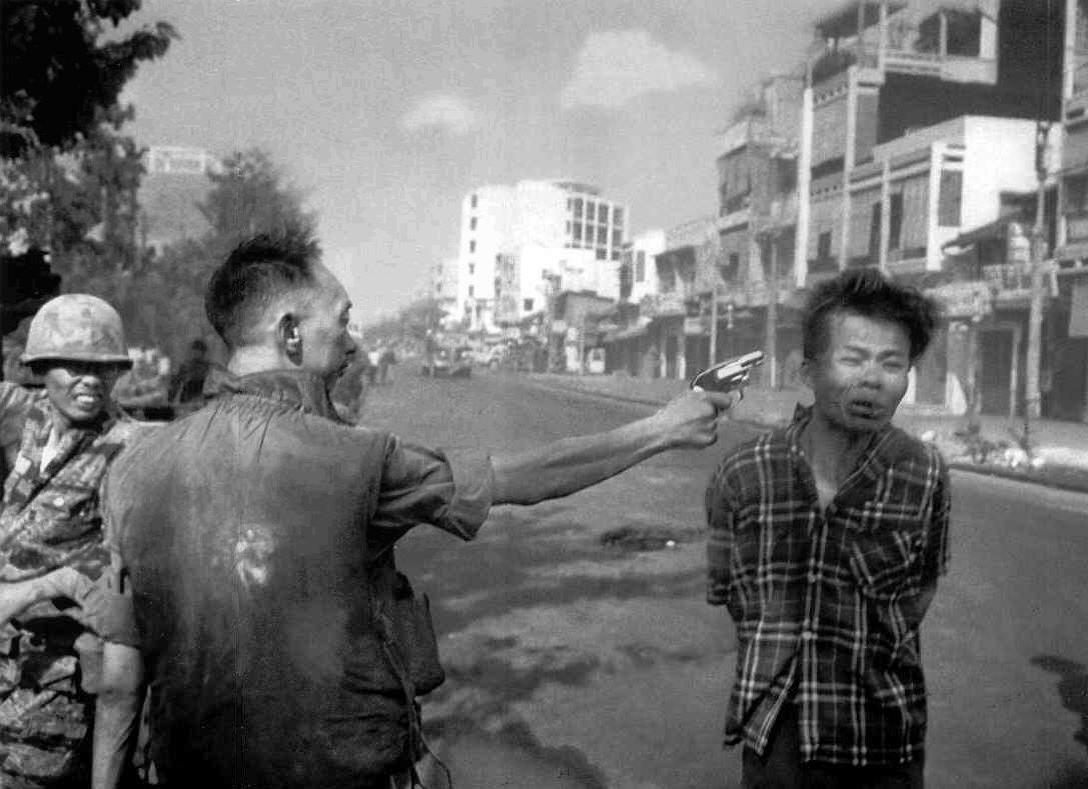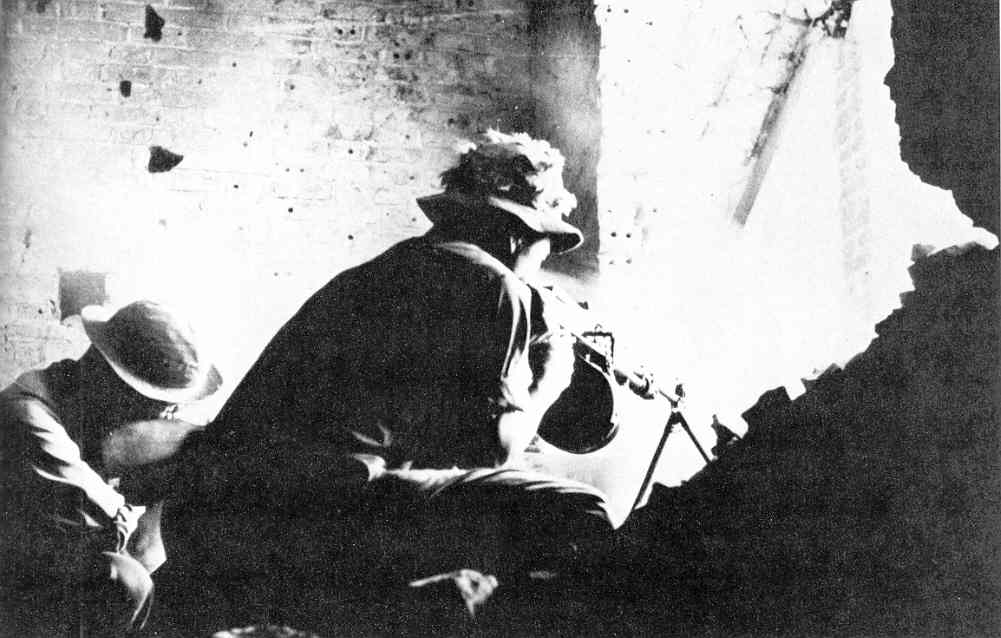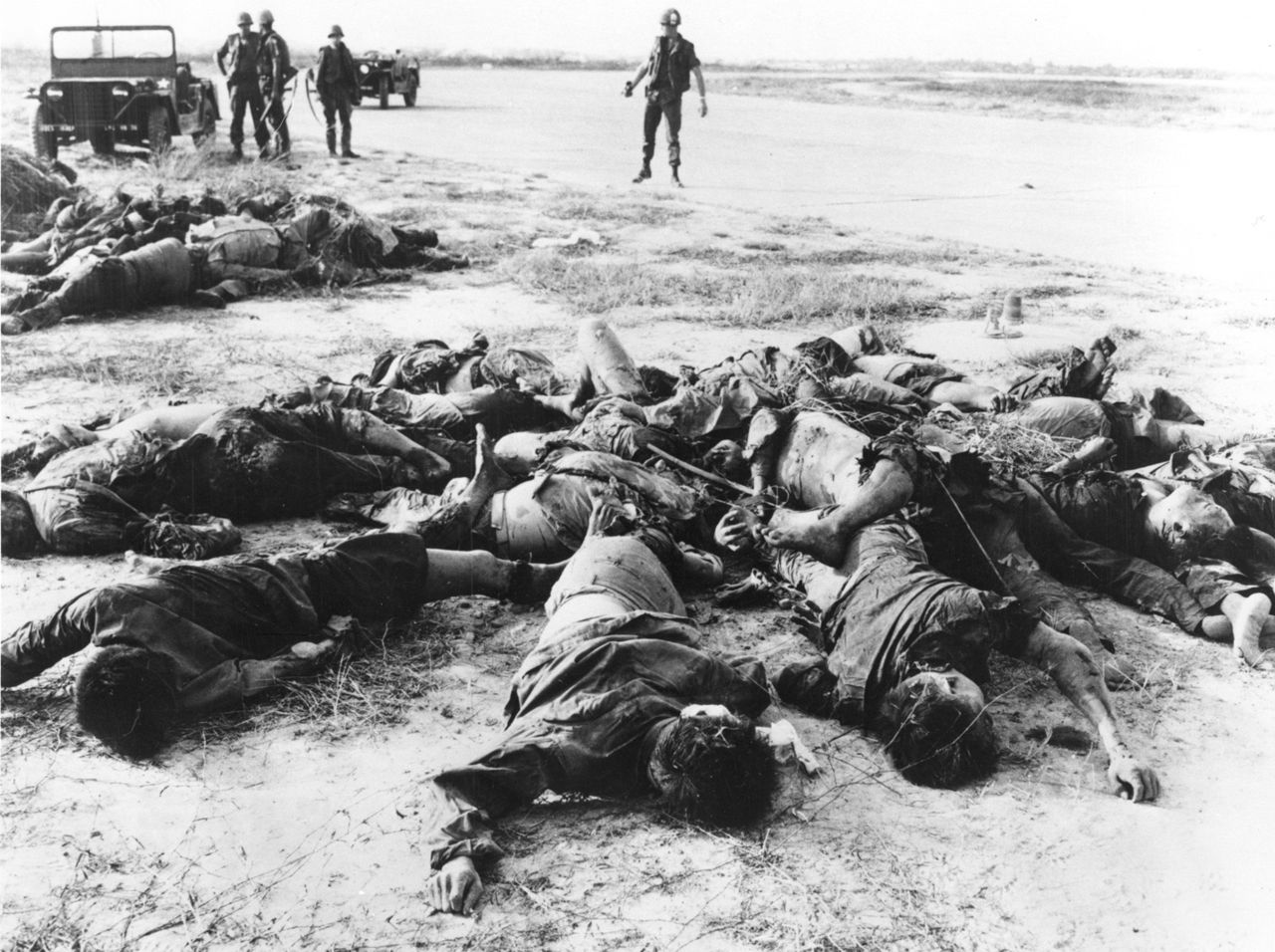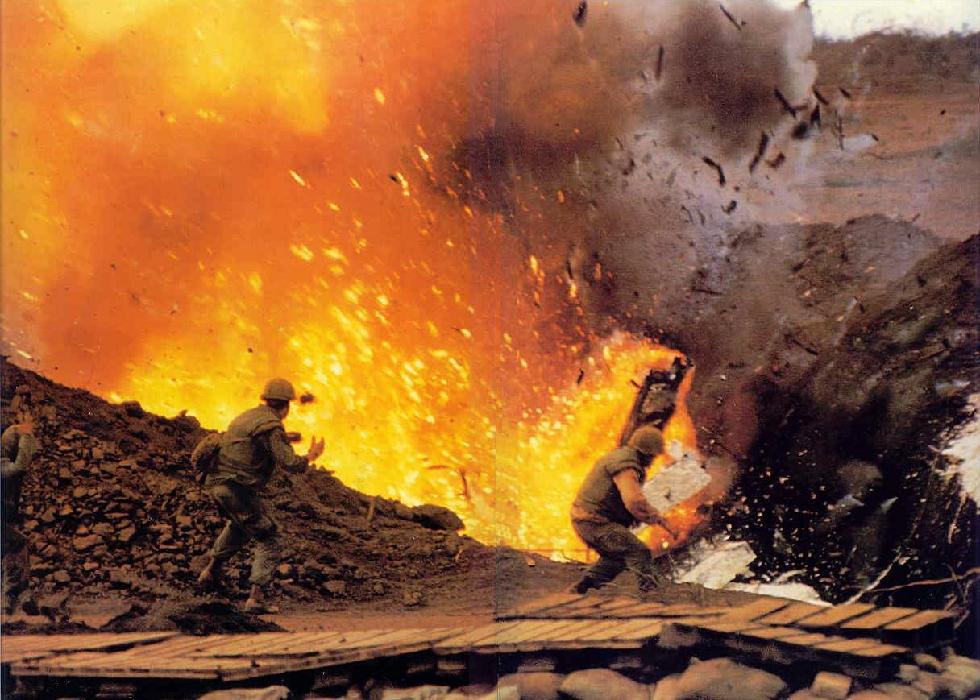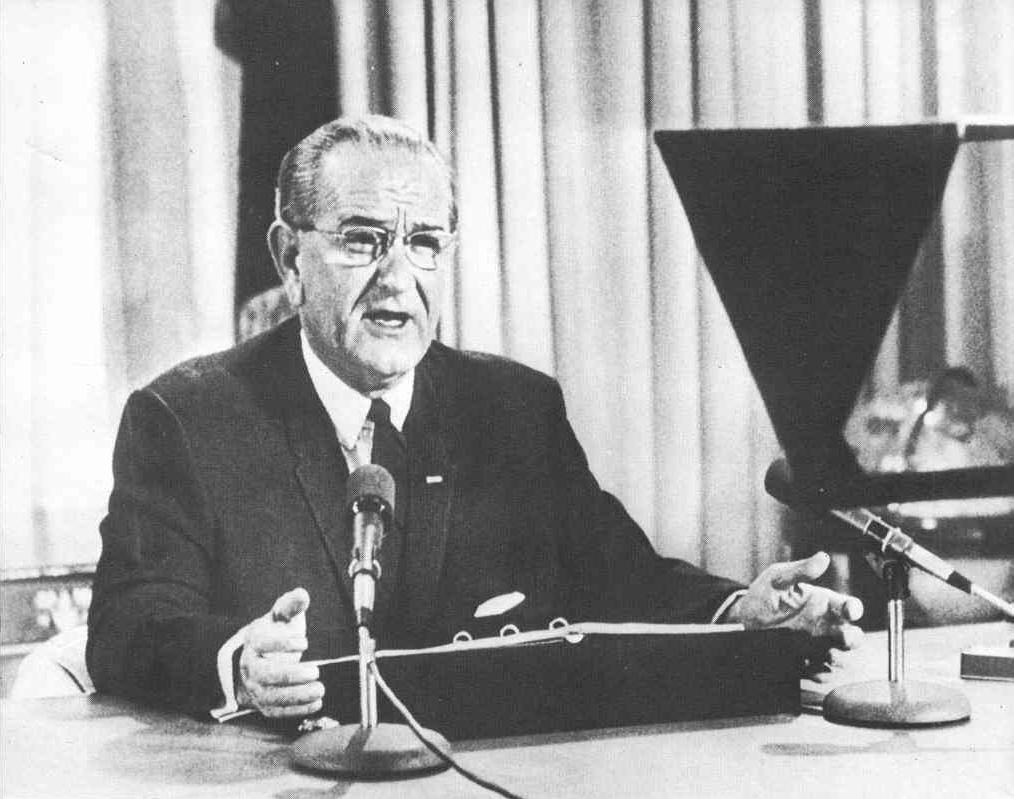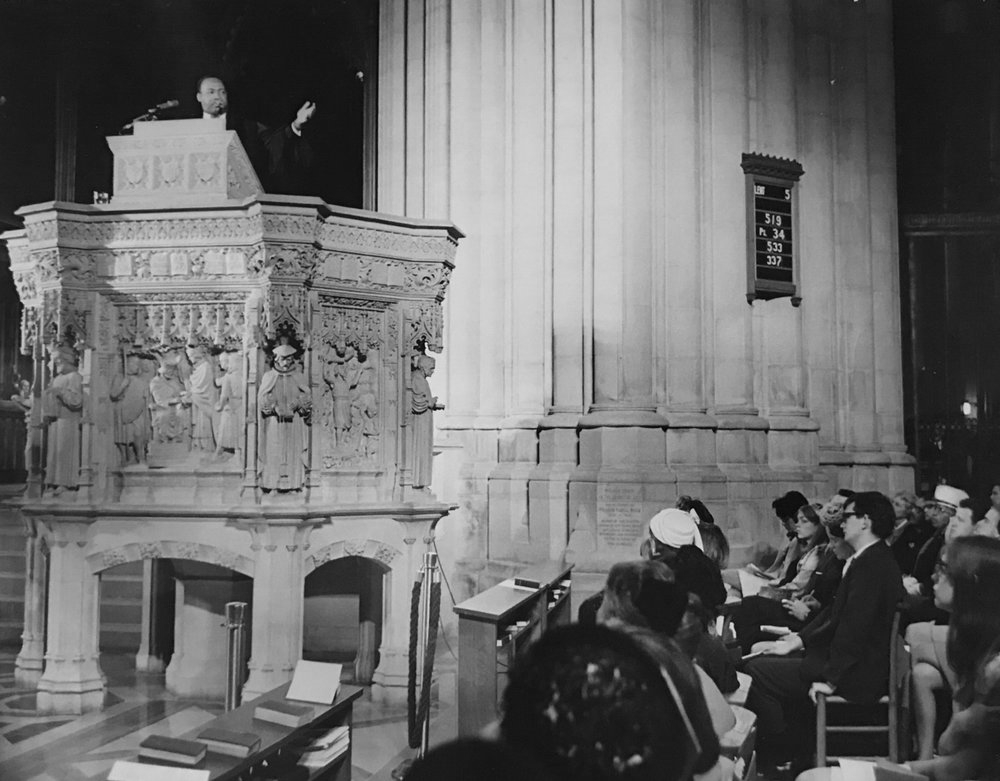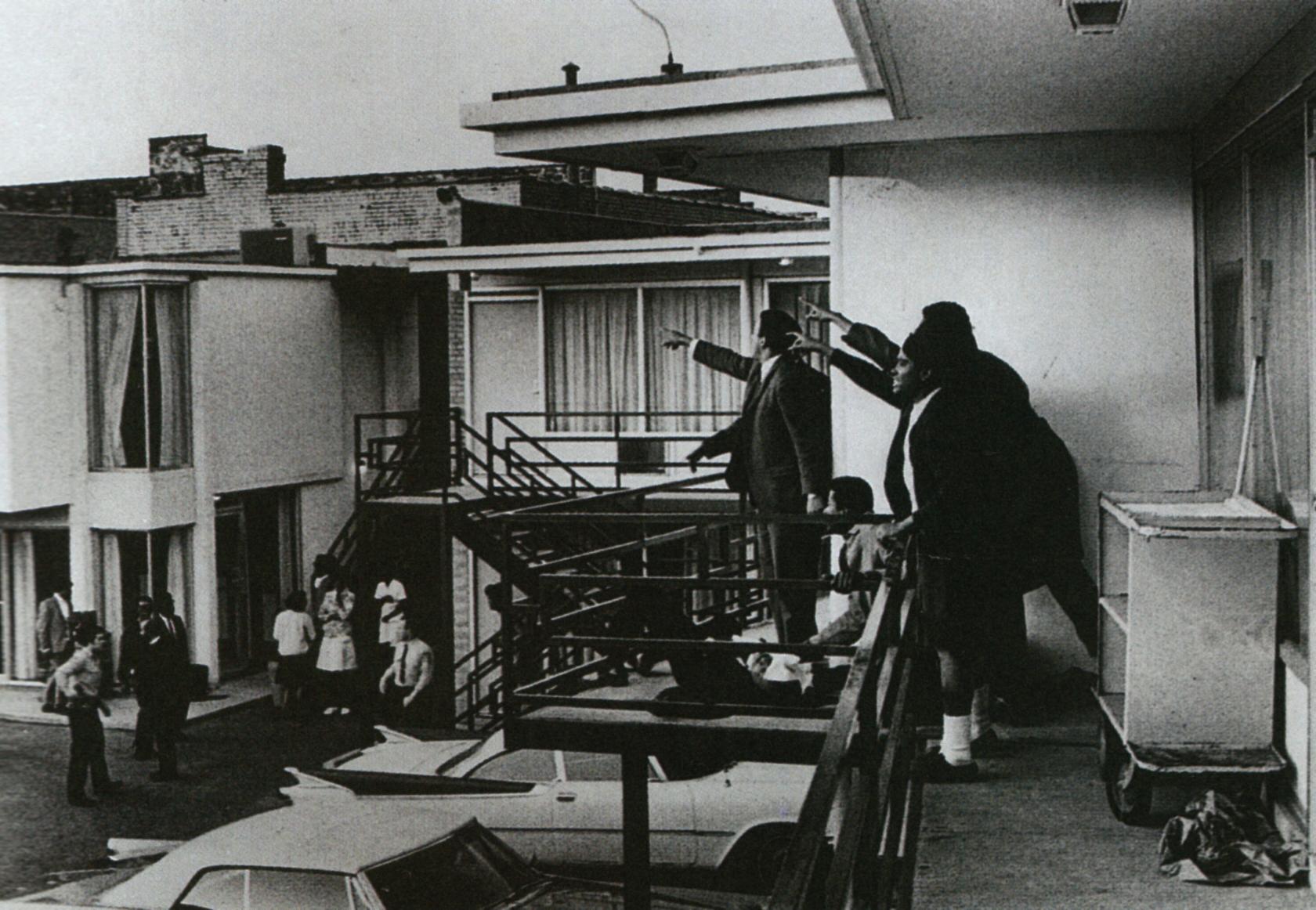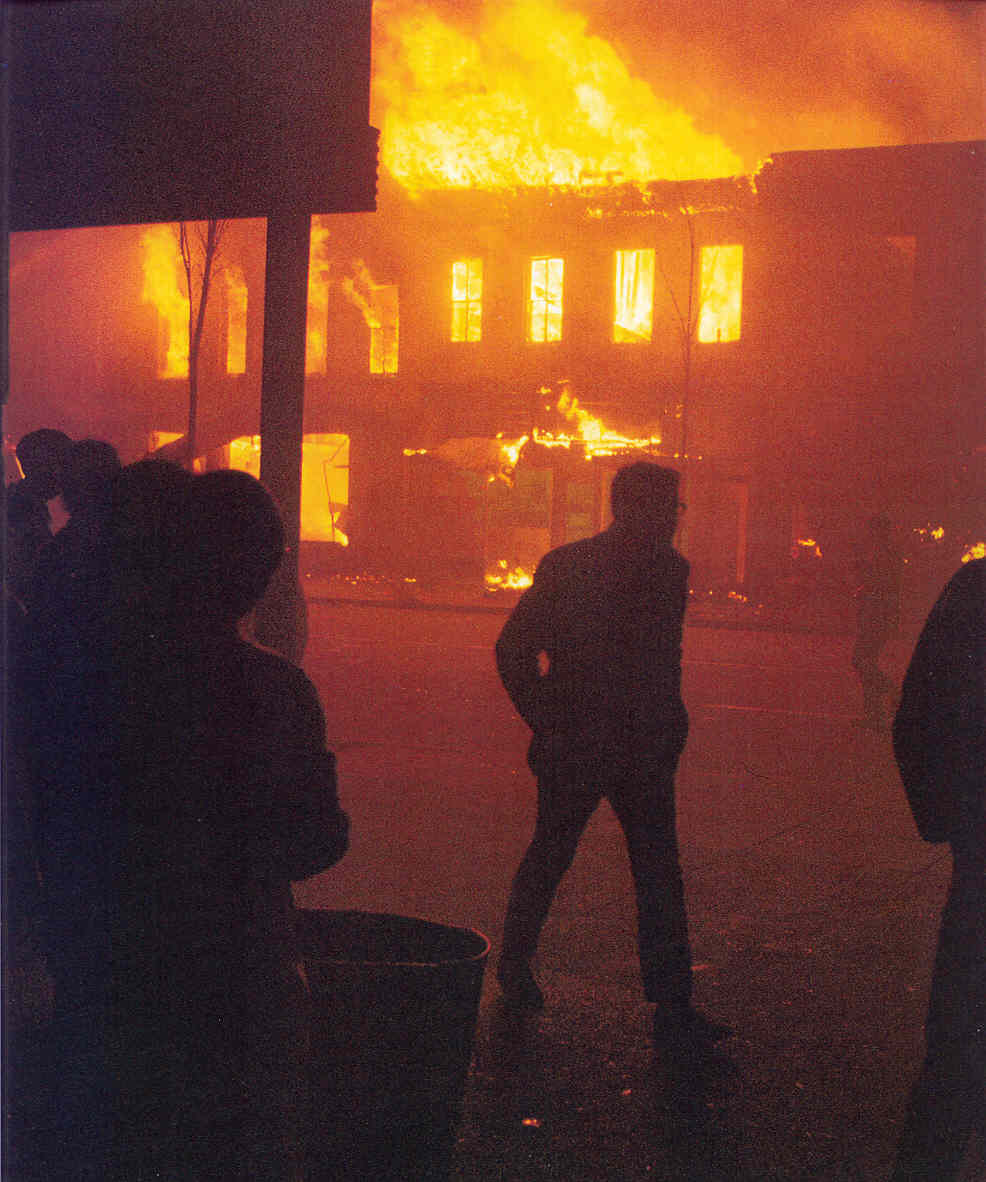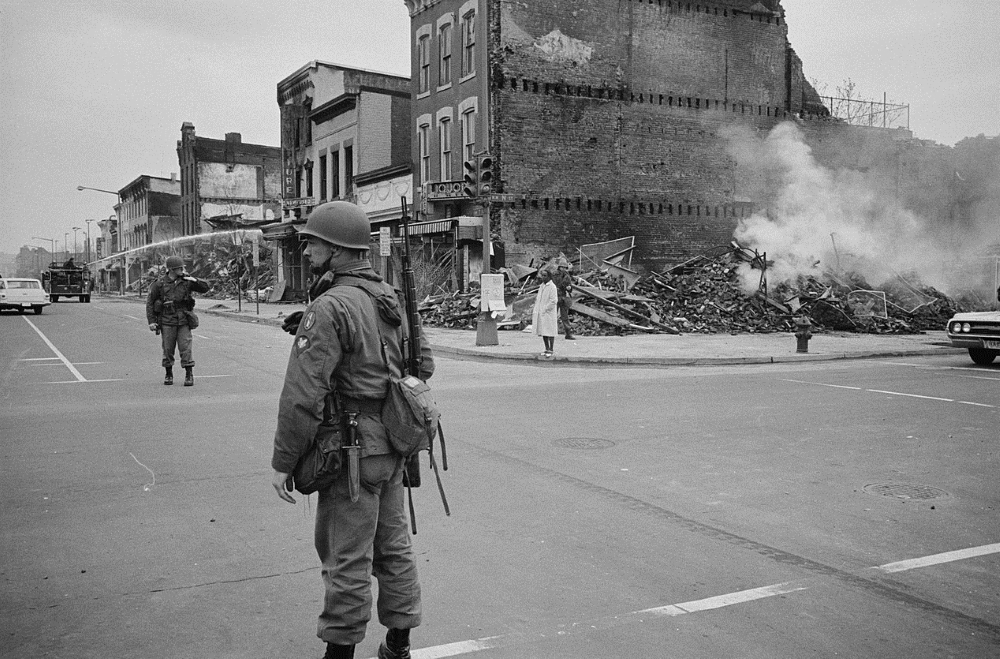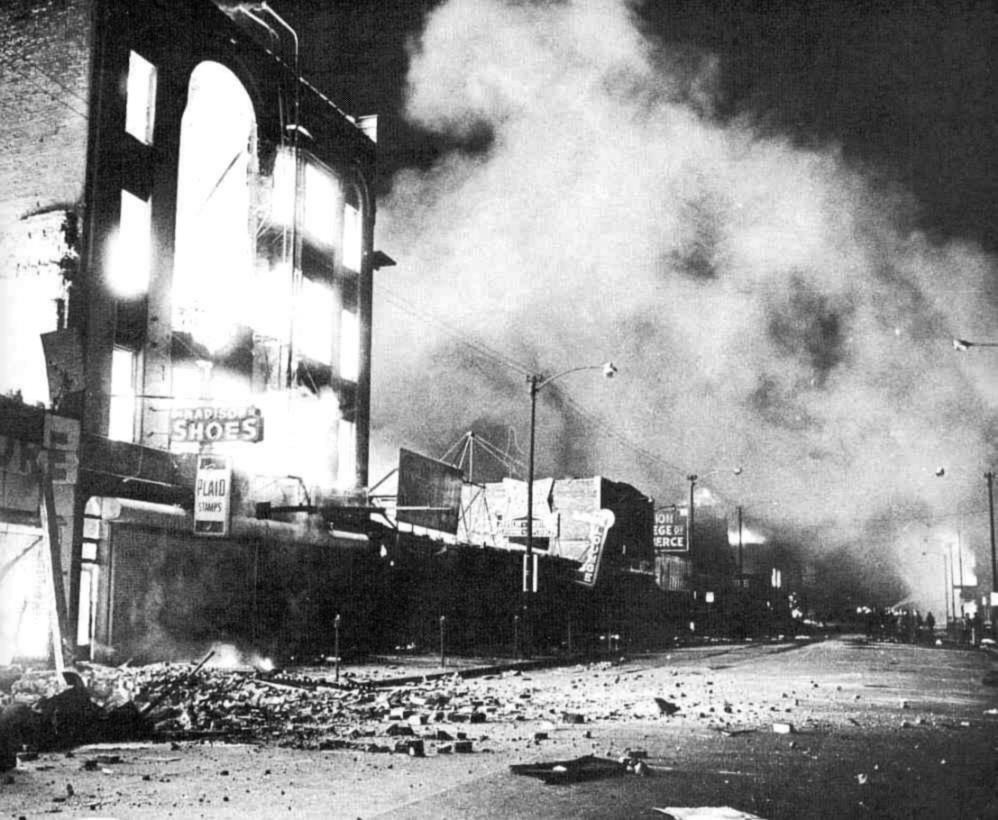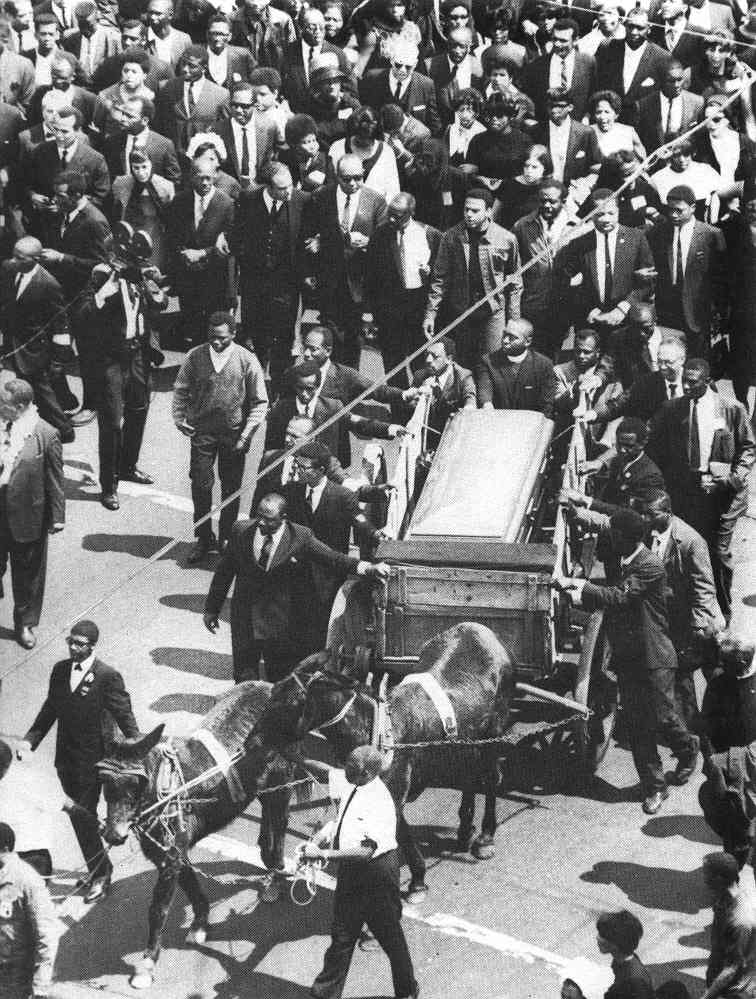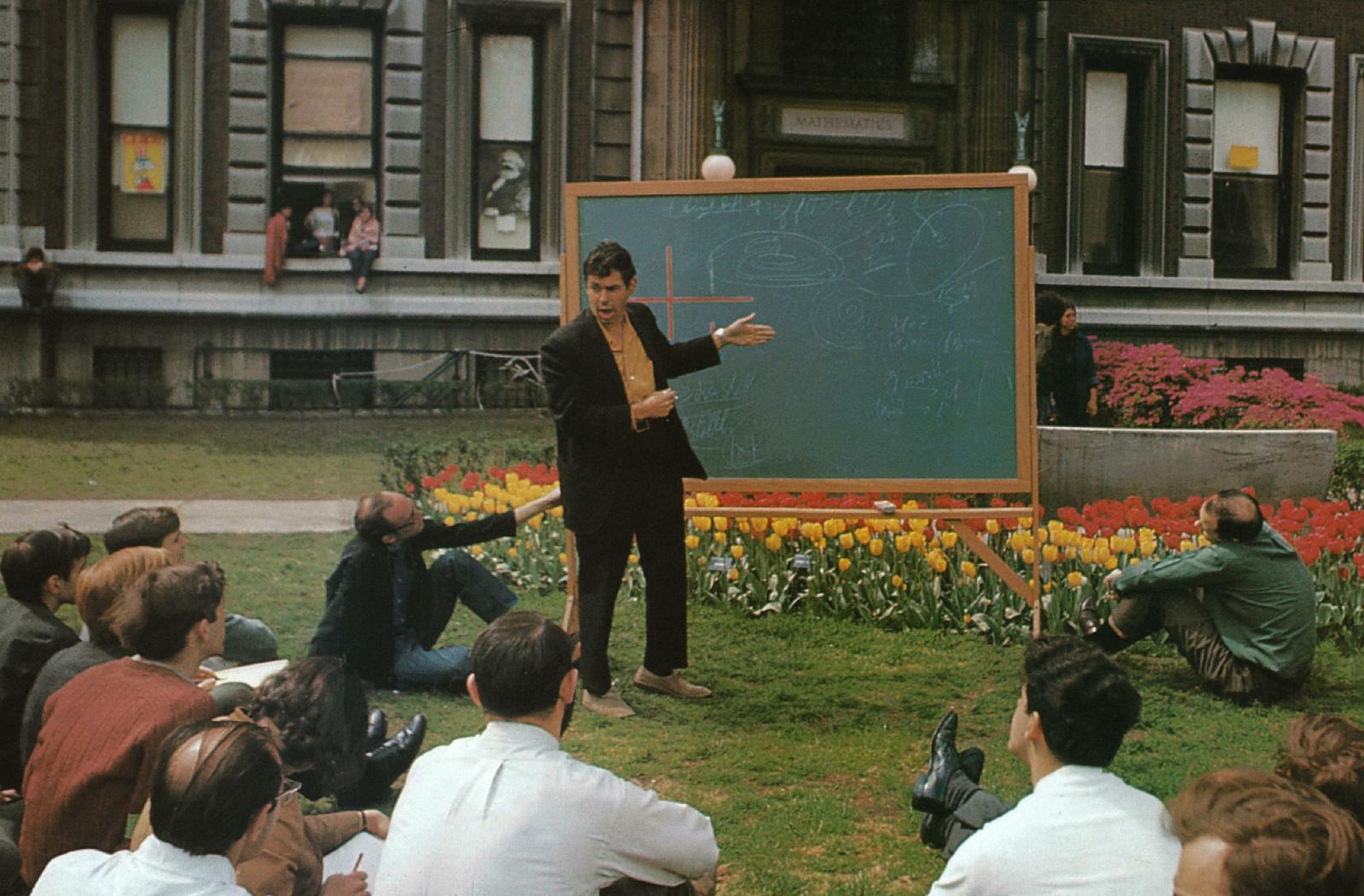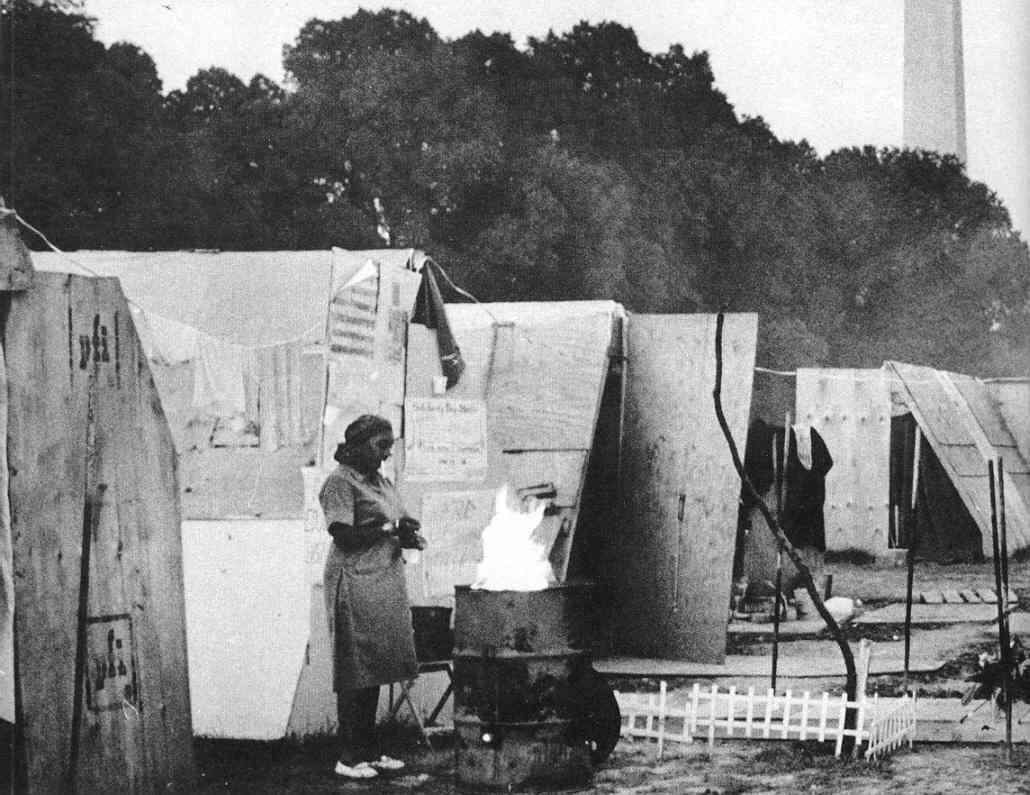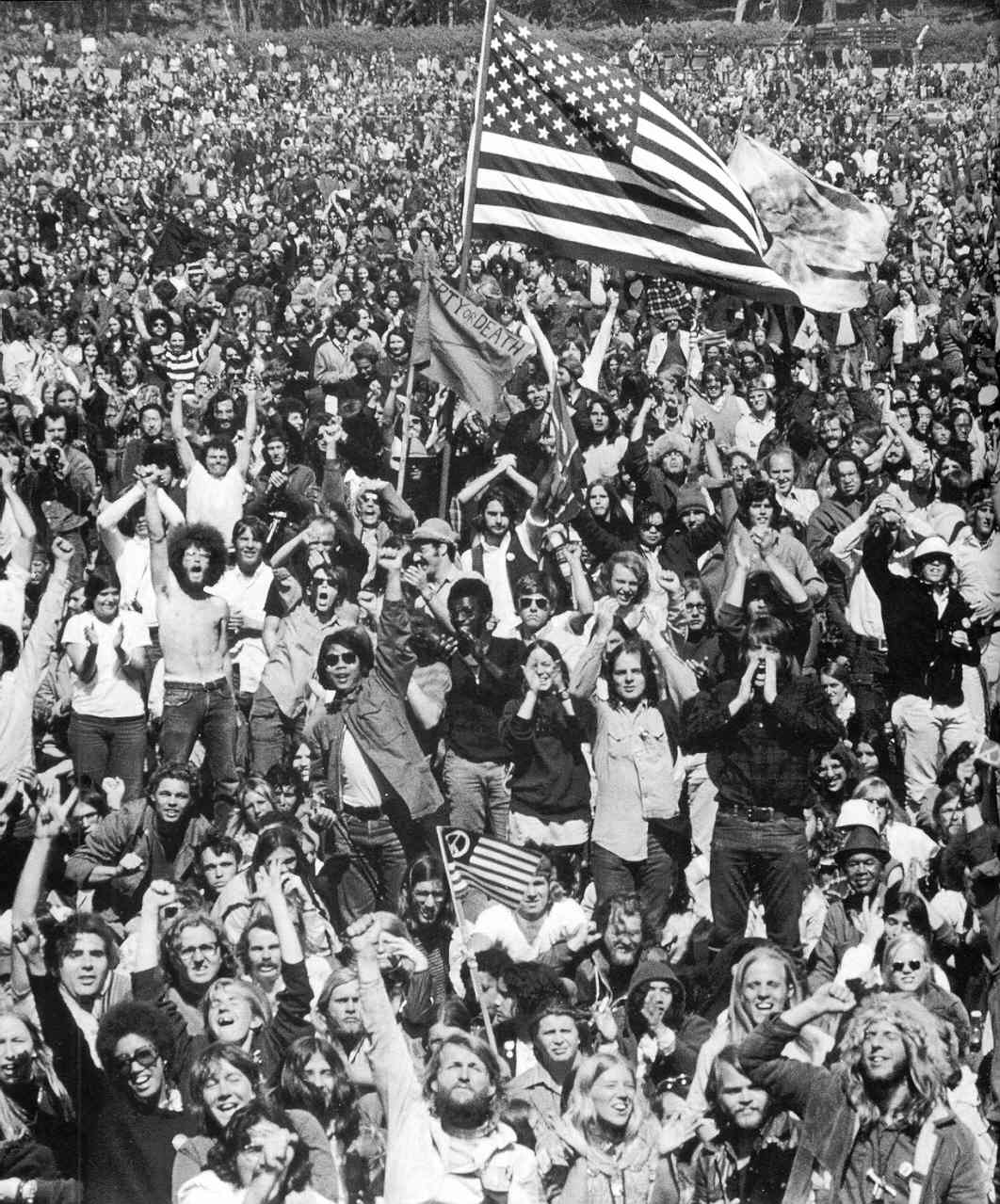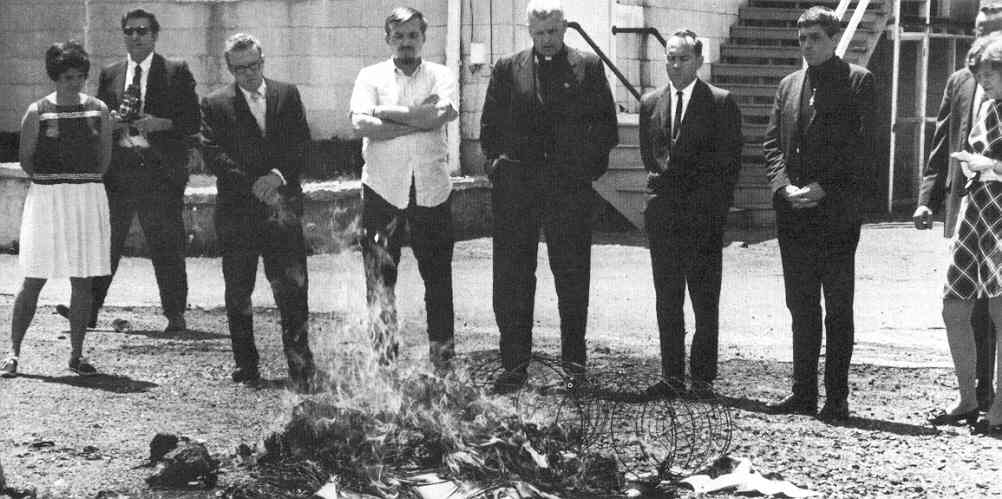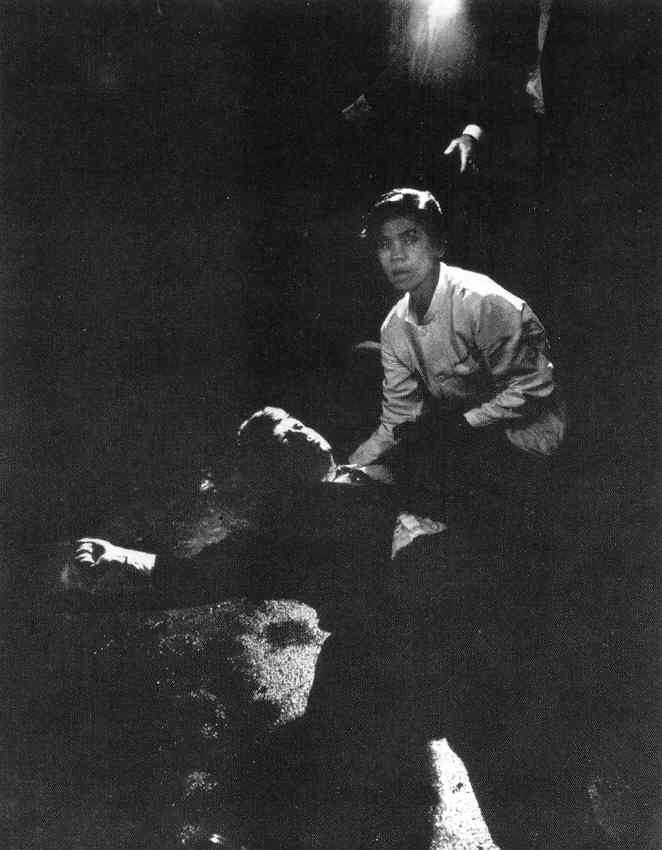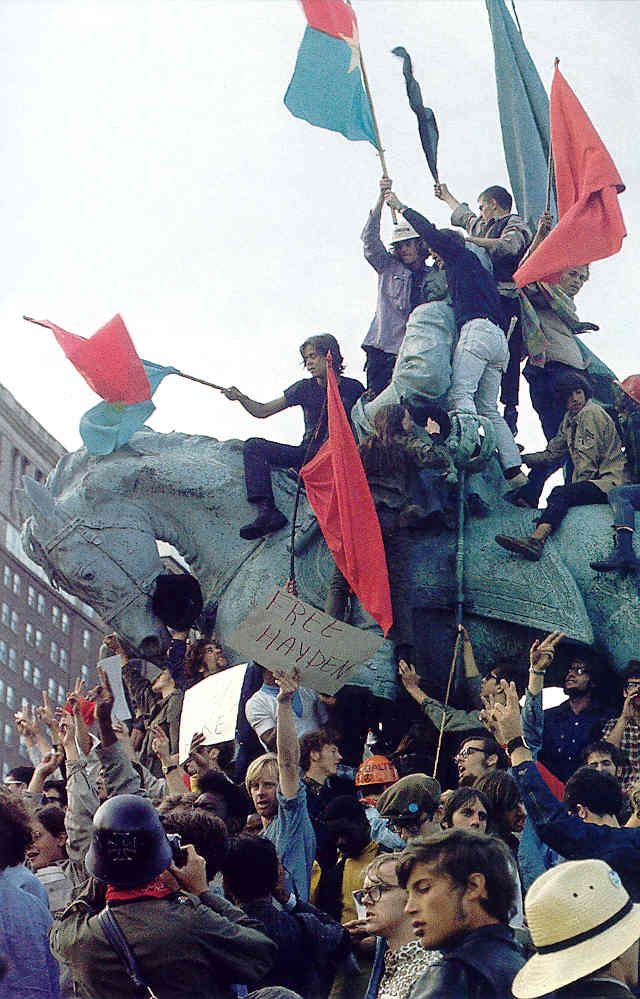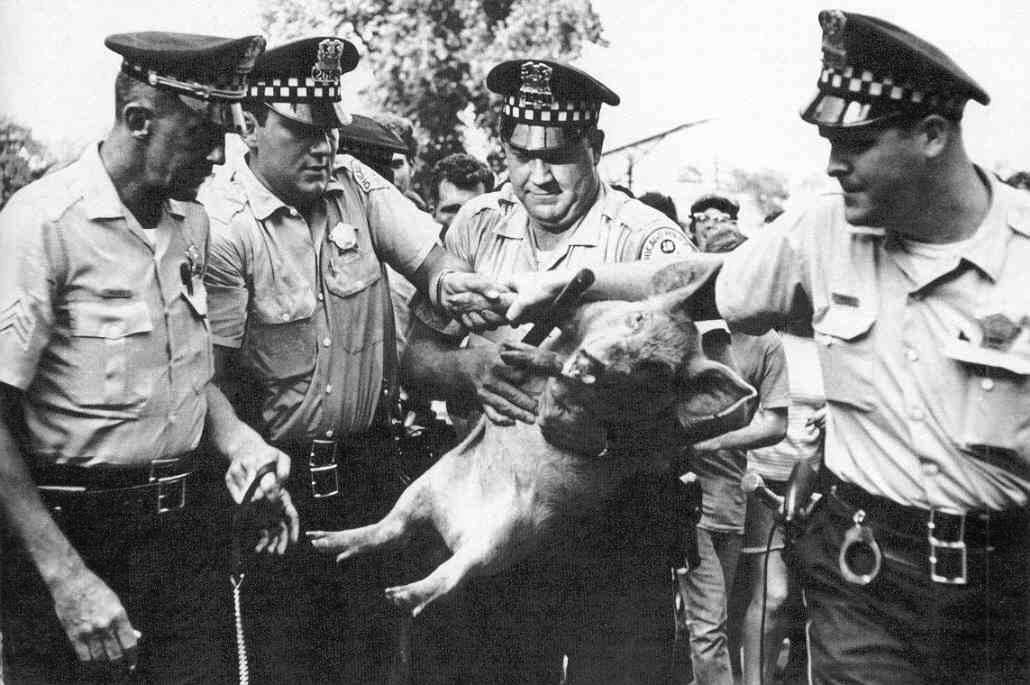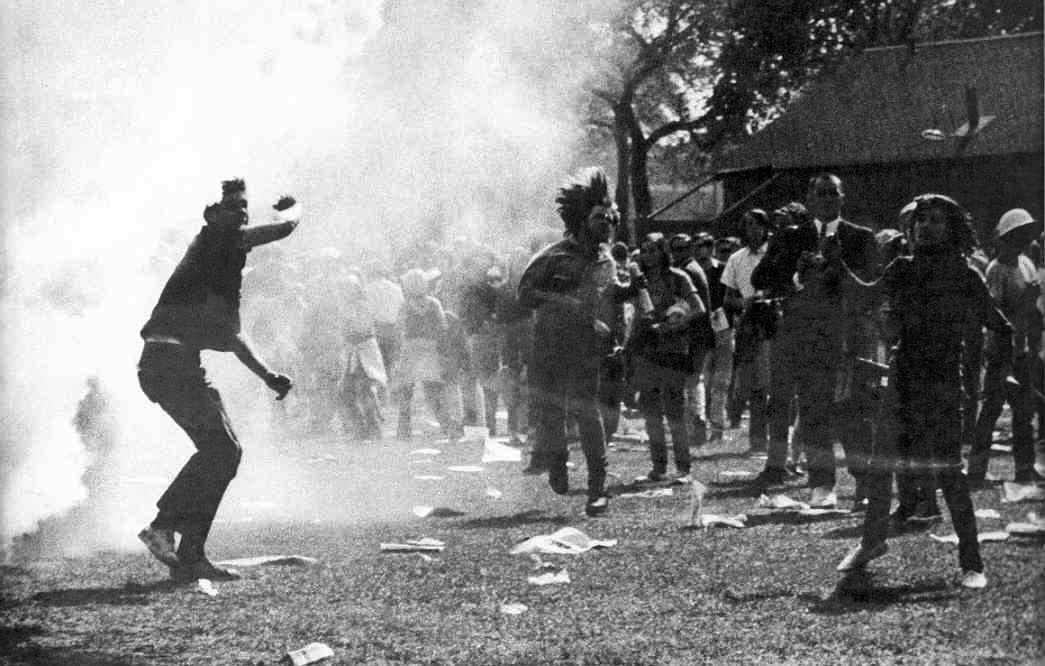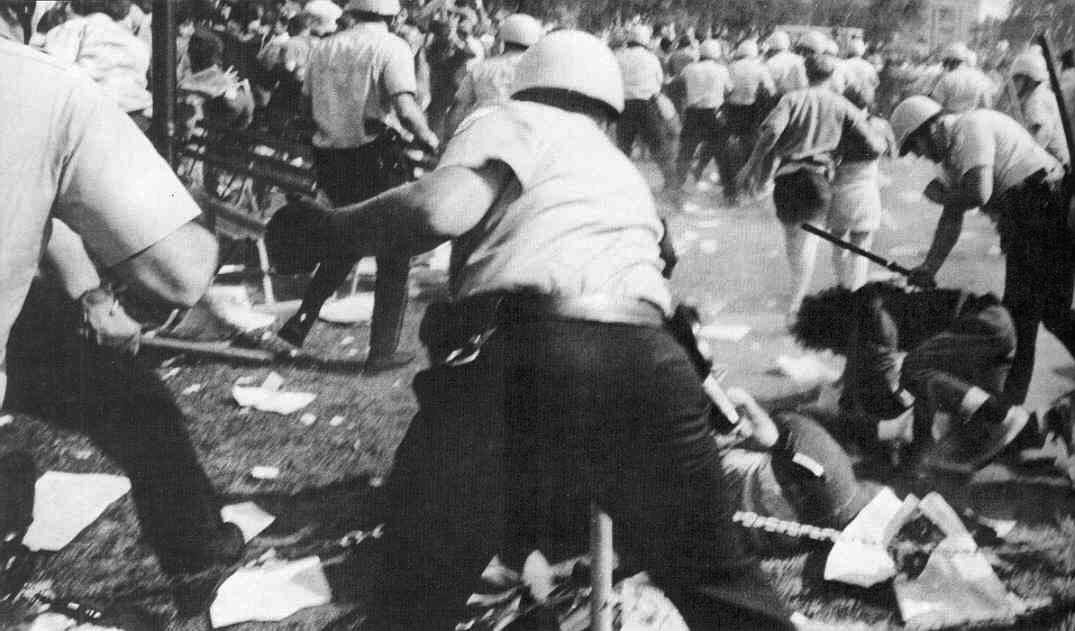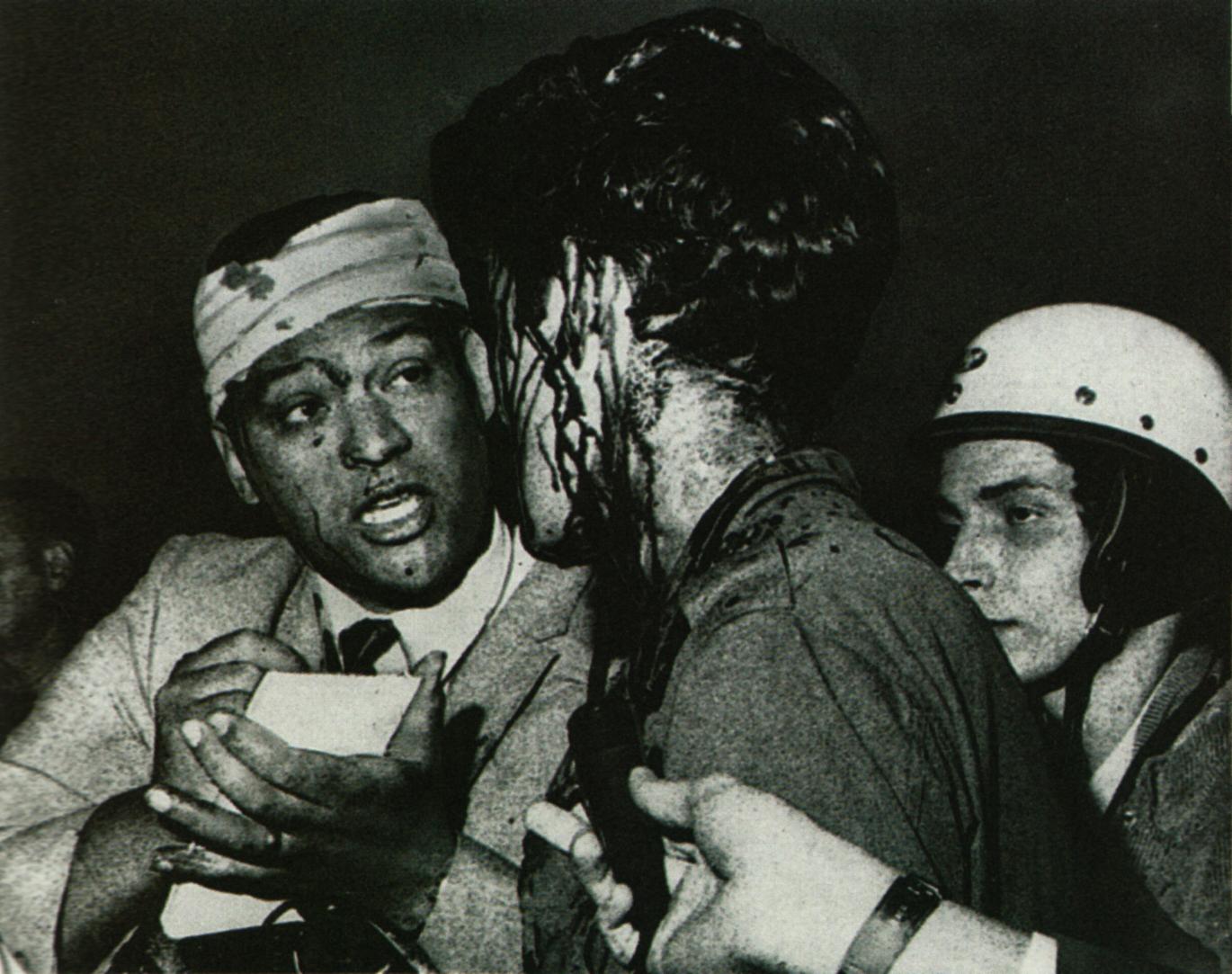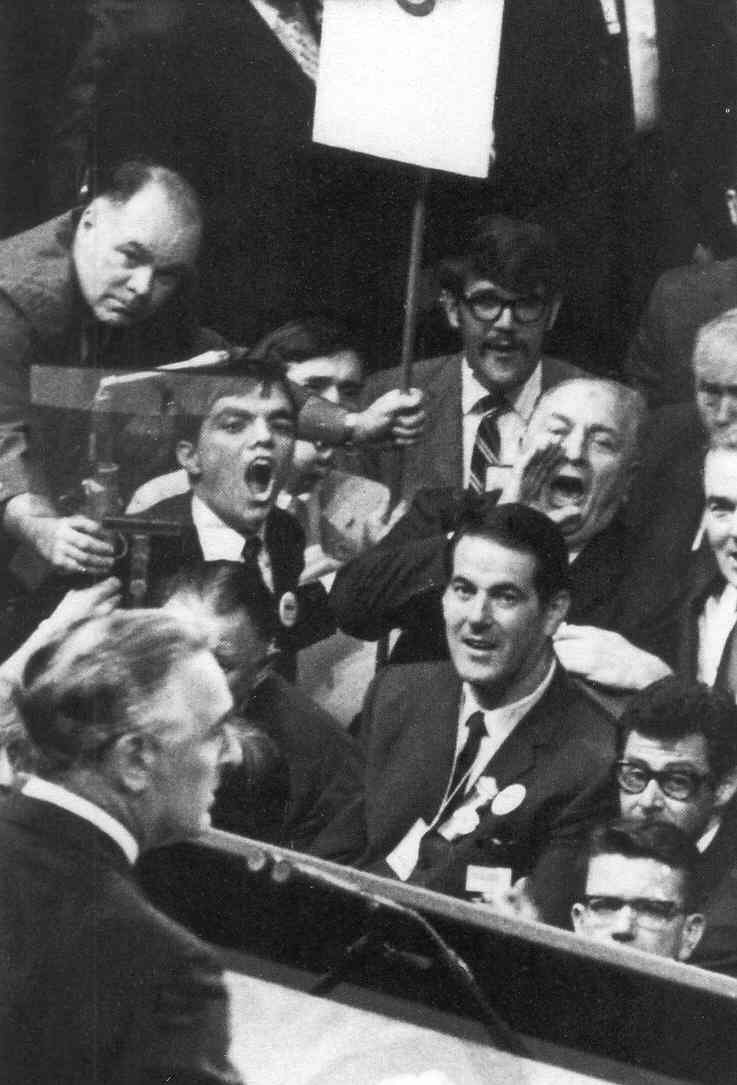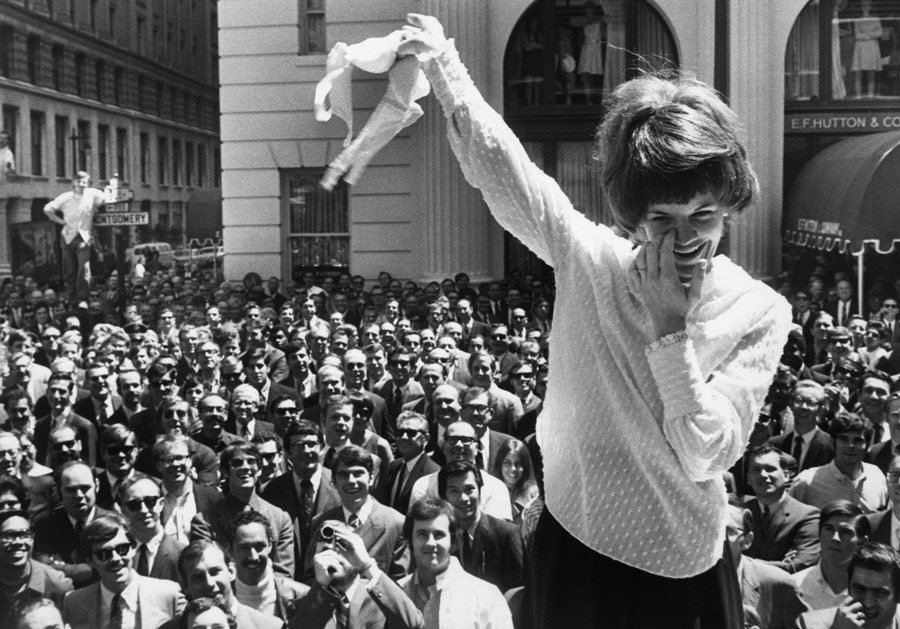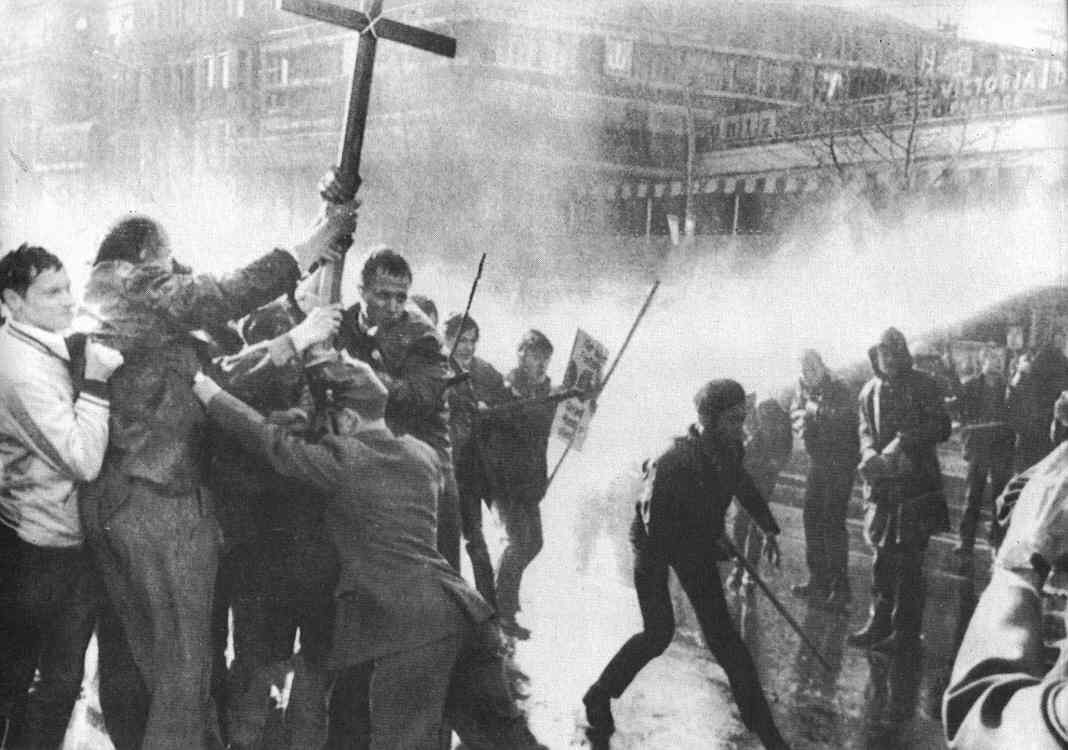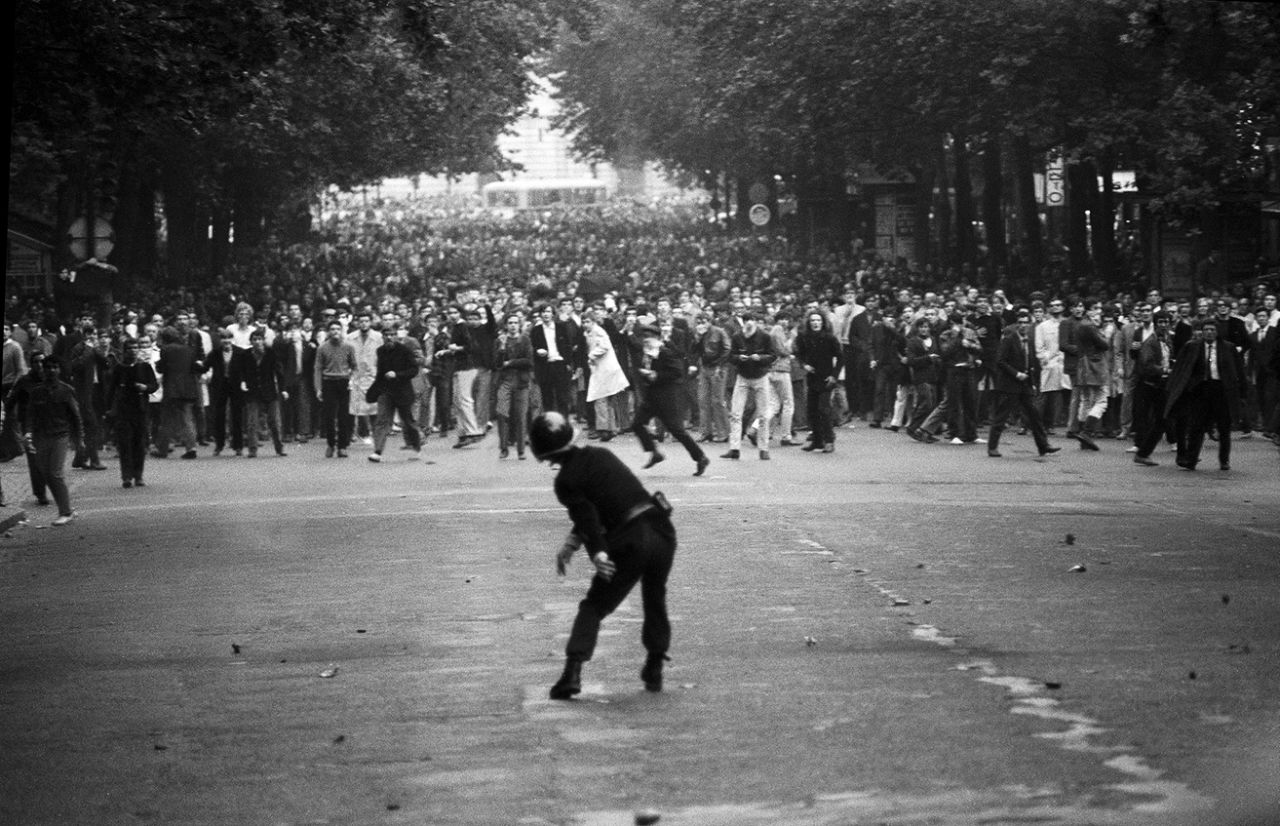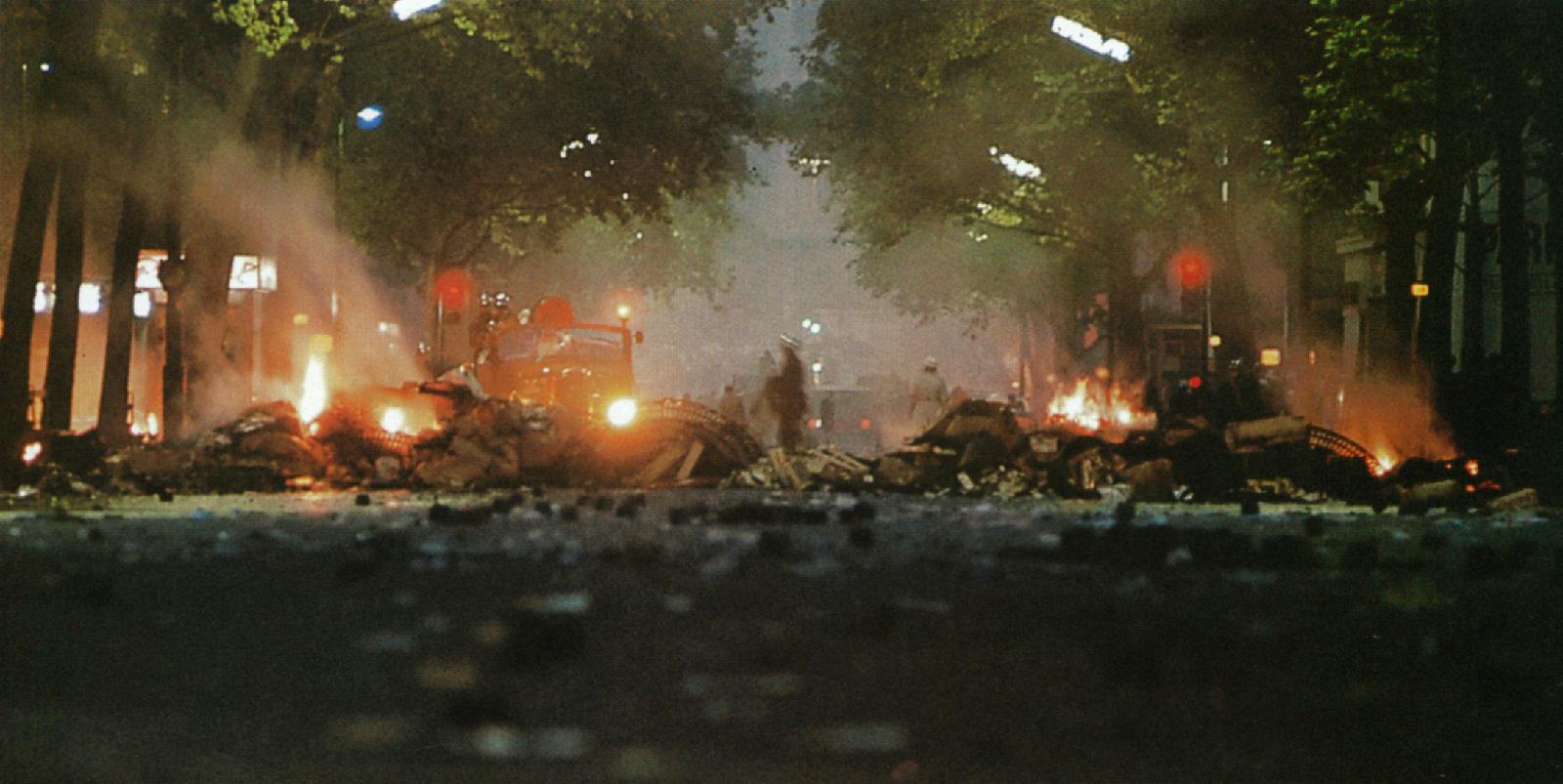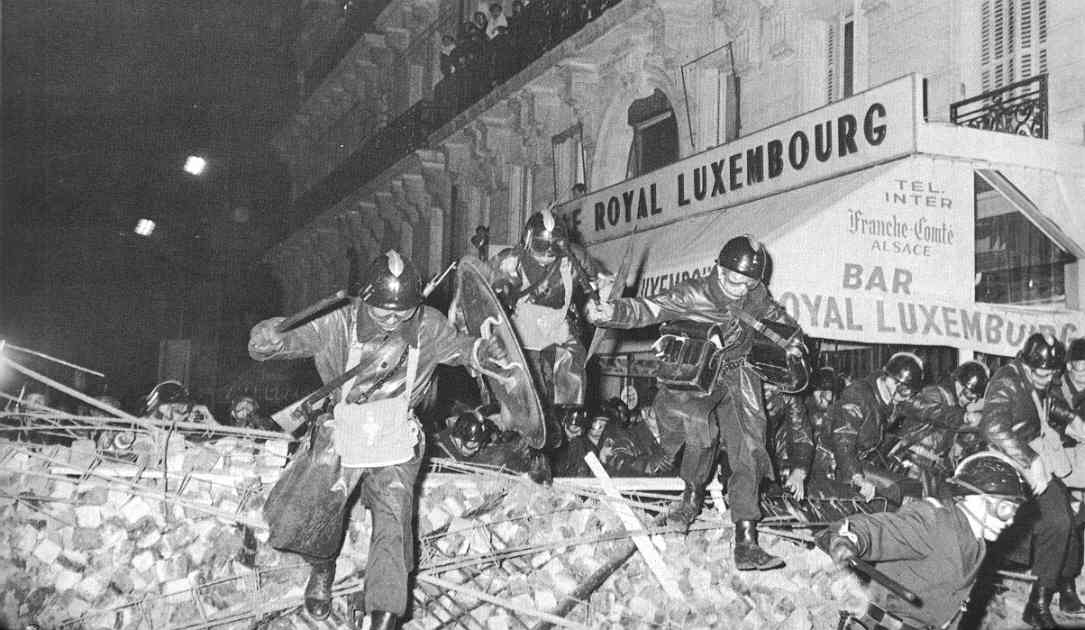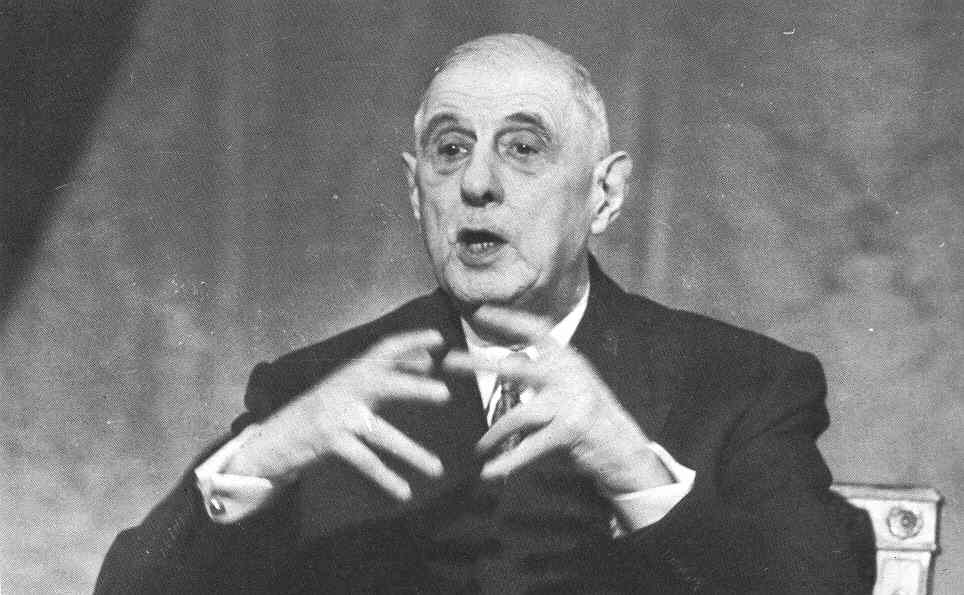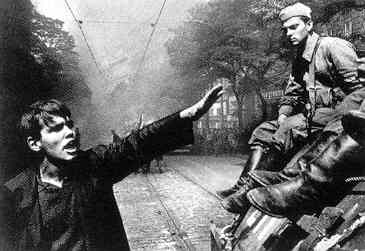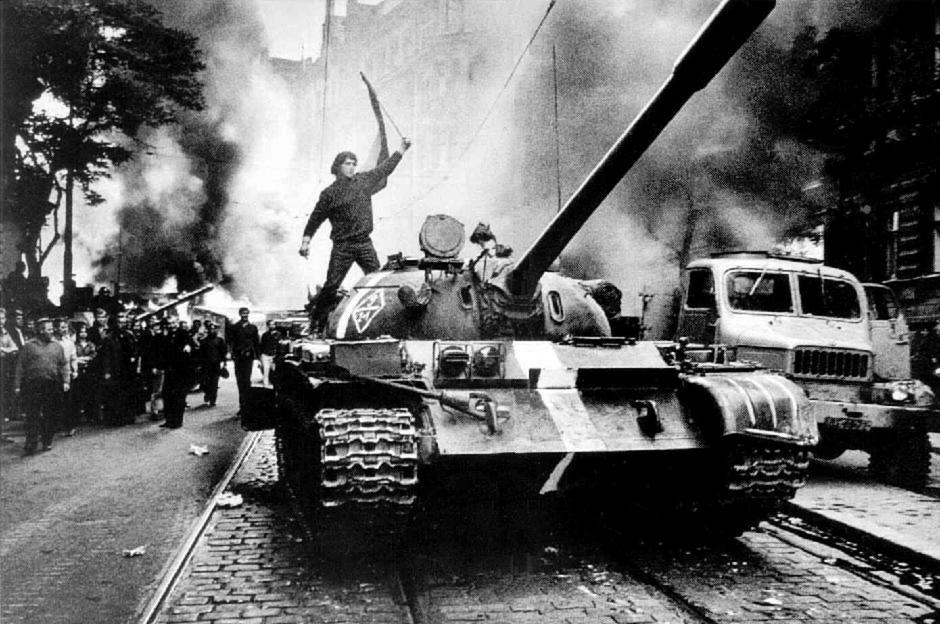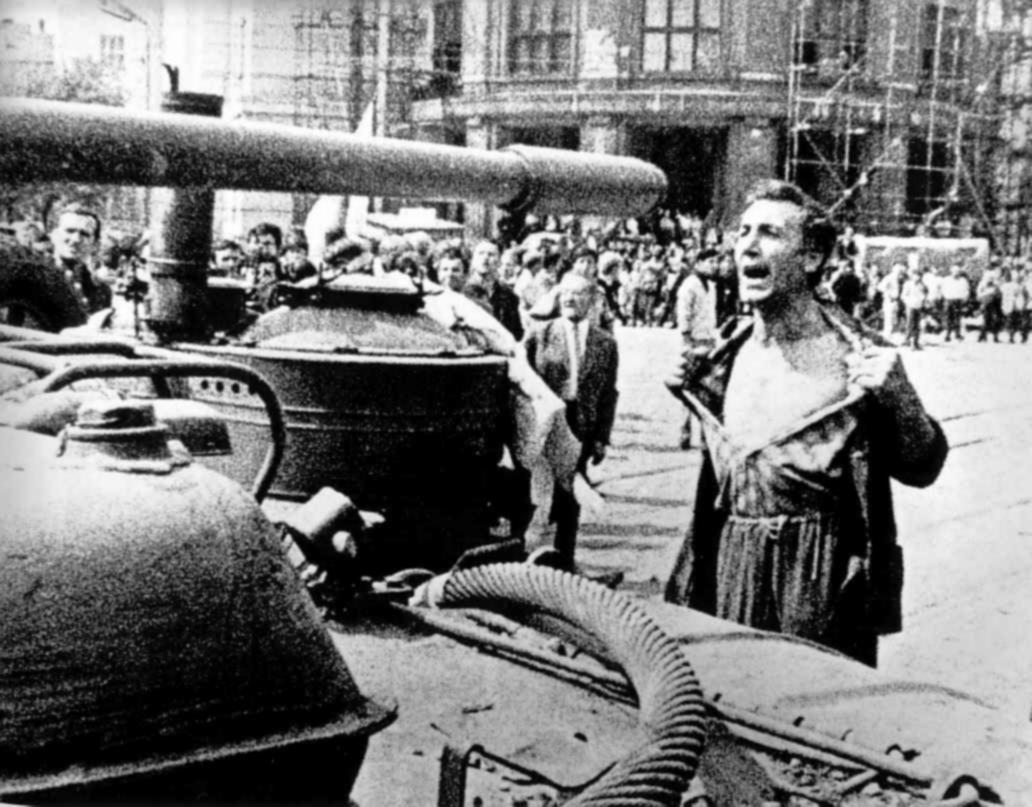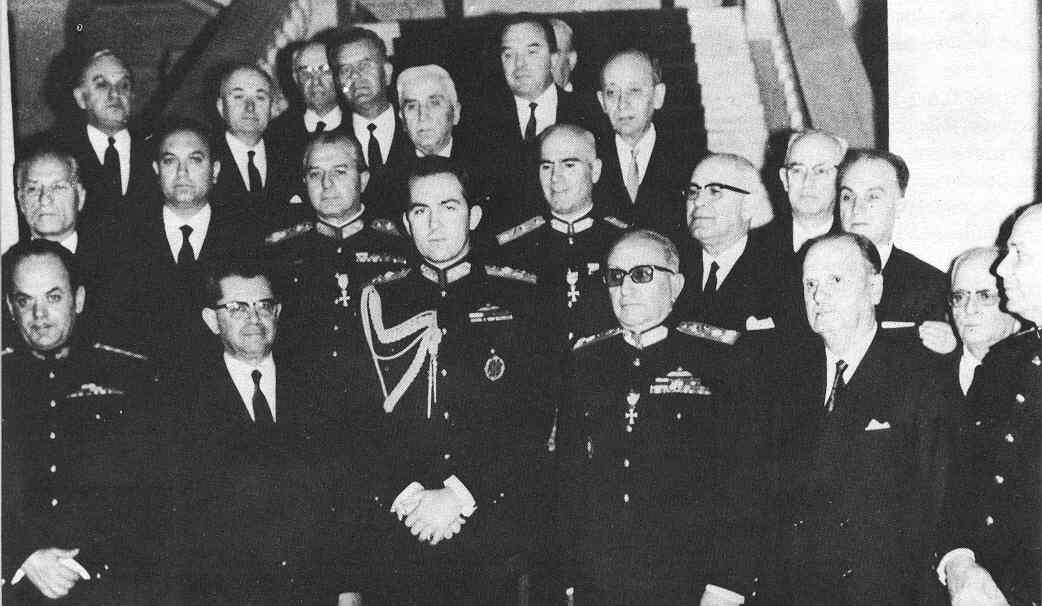19. THE SETTLING IN OF THE COLD WAR


1968 - THE ANNUS HORRIBILIS
 1968: A series of tragedies hits America
1968: A series of tragedies hits Americastrongly
 Student rebellion in West Germany
Student rebellion in West Germany
 The "Prague Spring" in Czechoslovakia
The "Prague Spring" in Czechoslovakia
 The overthrow of the Papandreou
The overthrow of the Papandreou
Government by the Greek military
The textual material on page below is drawn directly from my work
A Moral History of Western Society © 2024, Volume Two, pages 310-317.
1968: A SERIES OF TRAGEDIES HIT AMERICA STRONGLY |
|
The Vietnam Tet Offensive (January-February)
At the end of January of 1968, America was shocked to wake up to the news that Viet Cong fighters had hit hard every American position across South Vietnam … even the supposedly secure capital city Saigon. In fact they were able to break into the American embassy compound there and kill the marine guards … something graphically displayed in the American TV evening news. This threw patriotic Americans into confusion, for the event seemed to contradict so strongly Johnson’s assurances that America was making great progress in the conduct of the war. Actually this was not at all untrue. Things were not going well for the Viet Cong. And their soldiers were growing exhausted … something that the American public had no way of knowing. Thus this "Tet Offensive" (conducted during the Vietnamese Tet Lunar New Year holidays) was undertaken as a desperate measure as something as a last bold shot at the Americans … in order to tire the Americans of the war before the Viet Cong themselves tired out. And they succeeded – although it nearly destroyed the Viet Cong army in doing so. The event succeeded in getting the American press – totally unaware of the reality of the situation in Vietnam – to put before the American public the verdict that the Vietnam War was a total failure. |
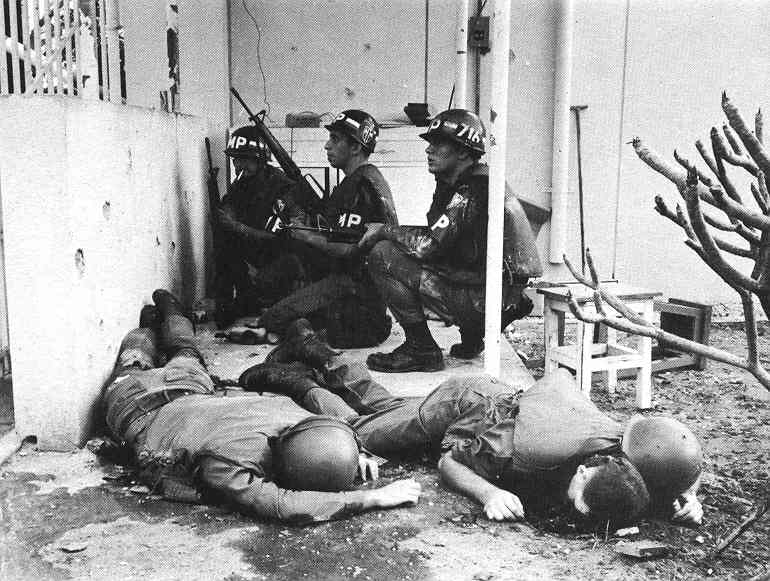
MP's returning fire from
inside besieged US Embassy in Saigon; two dead US soldiers killed
during the surprise Viet Cong Tet attack - end of January 1968
The U.S. Embassy after the
Viet Cong Tet offensive - January 1968
US military casualties at Hue during the VC Tet offensive - January-February 1968
Viet Cong suspect Bay Lop seized
by South Vietnamese troops during the Tet offensive II -
January 31,
1968
The supect is brought to
the commanding officer, Brigadier General Nguyen Ngoc Loan
General Loan enacts "justice"
on the spot
(this picture would appear
widely in the US news
- horrifying Americans and stirring anti-war
fever)
A North Vietnamese soldier in battle at Hue during the Tet Offensive - 1968
Dead Viet Cong killed outside the perimeter of the Tan Son Nhut Air Base during the Tet Offensive (Feb. 1, 1968)
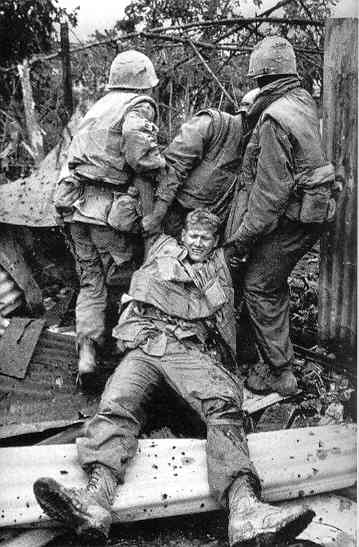
U.S. soldiers near Hue dragging
a wounded comrade to safety
Wearied troopers of the US
1st Cavalry Division taking a break in action near Hue - mid-March 1968
|
Johnson's announced retirement (March 31st)
Johnson himself was exhausted from having to fight the Vietnam war not only abroad but also at home. Any effort to convince the American population at this point would have merely brought on larger protests (especially from the Boomer youth) that their government was lying … and to be trusted in no matter at all. Indeed, so exhausted was Johnson that in concluding a televised speech at the end of March, he added something that was not on the written speech passed out beforehand to the American press: he would not be running for reelection as U.S. president in the upcoming November national elections. He was simply too tired to take on the challenge. Thus as for Vietnam – and his Great Society Programs – that would have to be the responsibility of others to deal with. Johnson was going home to Texas at the end of his term in the coming January. |
Johnson announces at the
end of a 45-minute TV broadcast that he will not seek reelection -
March
31, 1968
The Rev. Dr. Martin Luther King Is Assassinated (April 4th)
| Less than a week later, America was hit by another shock: Dr. King had been shot and killed by James Earl Ray while King was in Memphis, Tennessee, to lead a local garbage workers' strike for better wages and working conditions. King’s death not only deeply grieved Americans, it seemingly justified another – and quite extensive – Black plundering and torching of America's cities … across the country. Even Washington DC was put to the torch – and had to impose an emergency afternoon curfew, its empty streets patrolled by National Guardsmen … an action lasting several days. |
Dr. King's last sermon - Washingtion National Cathedral - Sunday, March 31, 1968
(and by some act of God, I was there to hear it!)
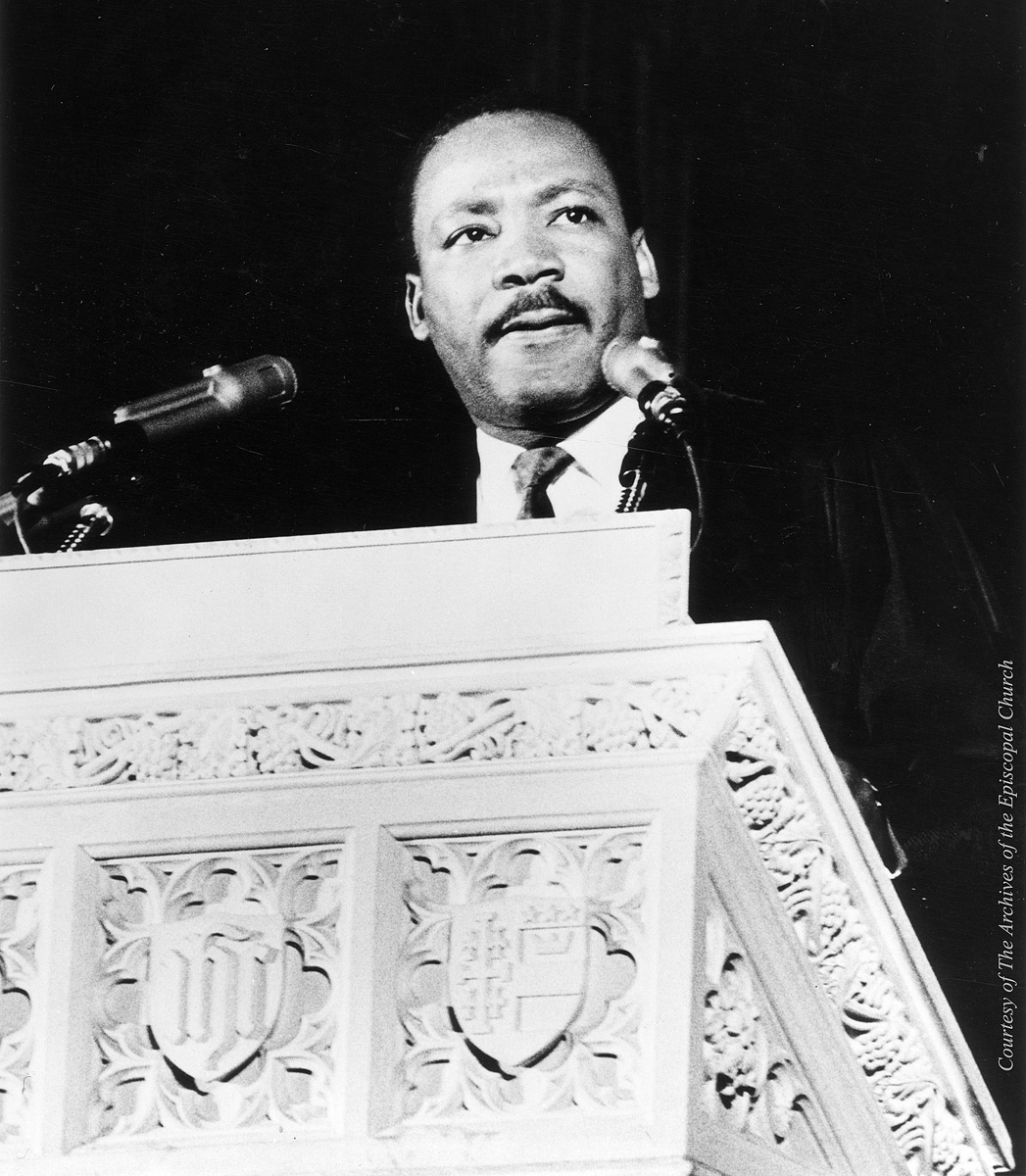
Most eerily (in retrospect), he spoke very prophetically about his focus on merely Black civil
rights being over (he was not going to be part of the Black Power takeover of the movement).
Little did he know how "over" that would be.
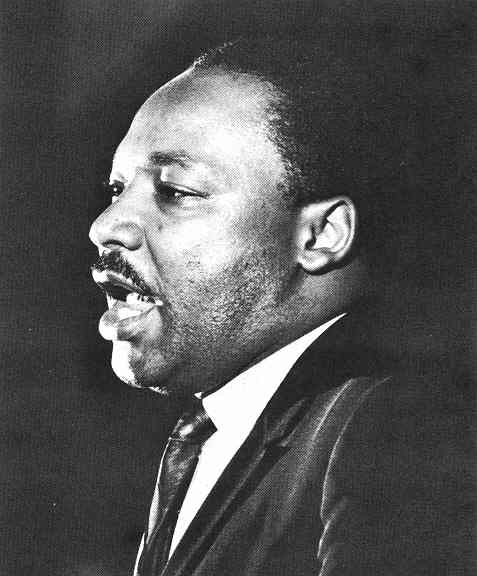
Dr. Martin Luther King, Jr.
during his last public appearance the night before his death - April
1968
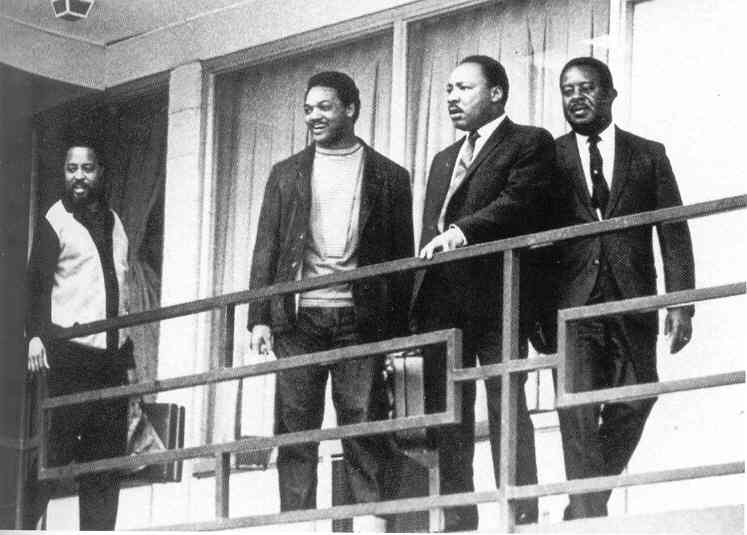
Dr. Martin Luther King on
the balcony where he would be shot on the following day
Rev. Dr. King's aides point to where the sniper shot that killed King came from - Memphis, April 4, 1968
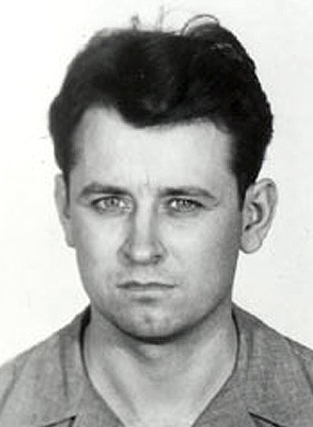
His assassin, James Earl Ray - a hard-core racist ... and prison escapee (1967)
earlier convicted of fraud, theft and robbery
Washington burning in the
wake of the assassination of Dr. Martin Luther King, Jr. - April 1968

National Guardsmen patrolling a burning section of Washington, D.C. - April 1968
Chicago burning in the wake
of Martin Luther King's assassination - April 1968
Mules bearing King's coffin through the streets of Atlanta - April 1968
Chaos and shutdown at Columbia University, New York City - April-May 1968
| But
not to be left out of the action, at the end of April, a student
protest led by Mark Rudd and his Students for a Democratic Society
(SDS) organization broke out on the Columbia University campus in New
York City. They were protesting the decision of the university’s
administration to build a gymnasium on undeveloped university land …
land that the university had been permitting local residents – mostly
Black – to use for their own gardening purpose. To Rudd and the
SDS, this decision simply to build there was another representation of
the deep anti-Black racism that ran through White society … and needed
to be stopped. They planned (Maoist style) to shut down the university
… until the university acknowledged its sins and backed down on its
plans. But the SDS was not the only voice to be heard among Columbia’s students. Some 2,000 other students (many simply hoping to graduate in May) – plus New York City police – took on the SDS occupiers of their campus buildings. It became a violent scene … but was so strongly supported by a widening number of students (and outsiders) that the university was effectively shut down for the school year. This event in turn inspired large numbers of American Boomer youth across the country to engage in their own rebellion against the fascism characteristic of the "American Establishment." |
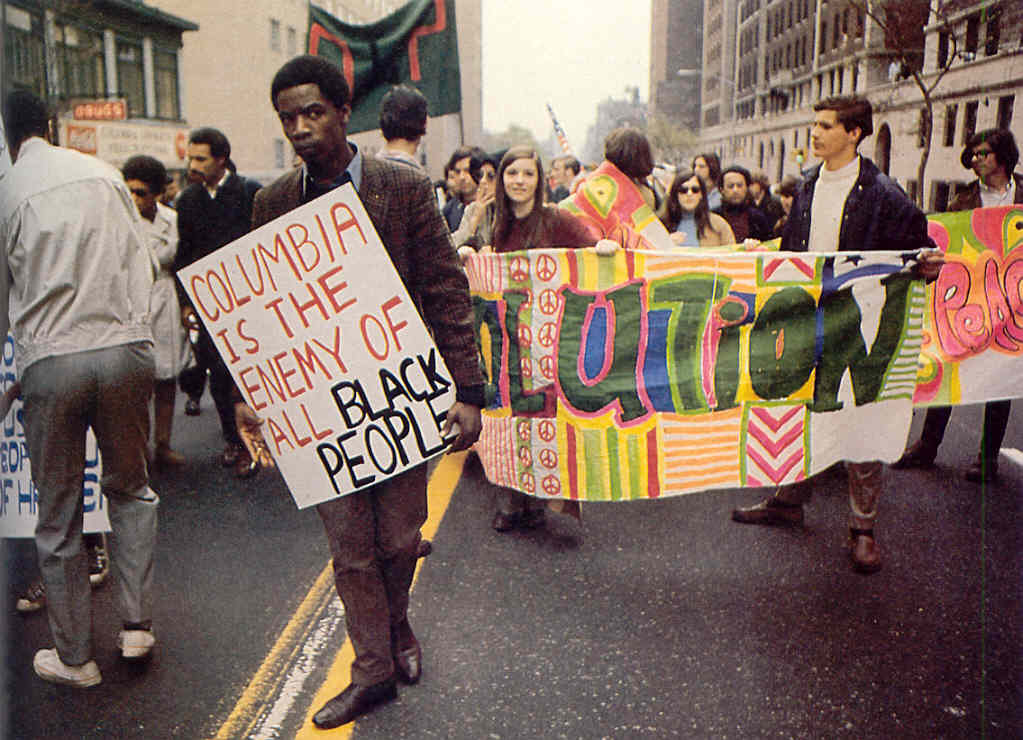
A protest against Columbia
University's decision to build a gymnasium in a Black neighborhood
in Morningside Heights
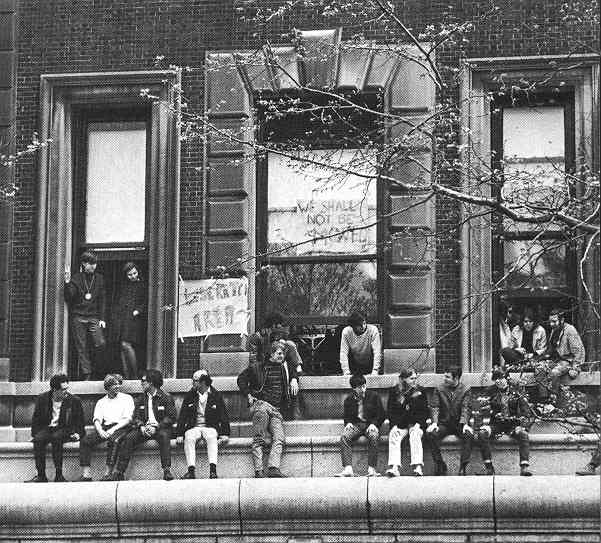
Columbia University students
occupying the Math building in protest against
the University's plans to build a new gymnasium on land owned by the university,
but used by the surrounding Black neighborhood for gardens - April 27, 1968
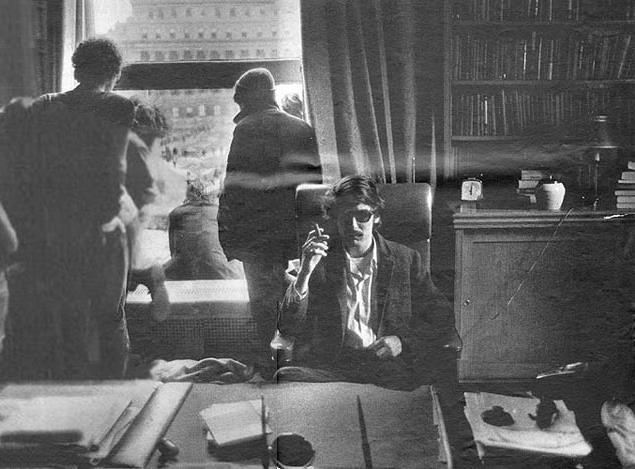
Students have taken over the office of Columbia President Grayson Kirk - April 1968
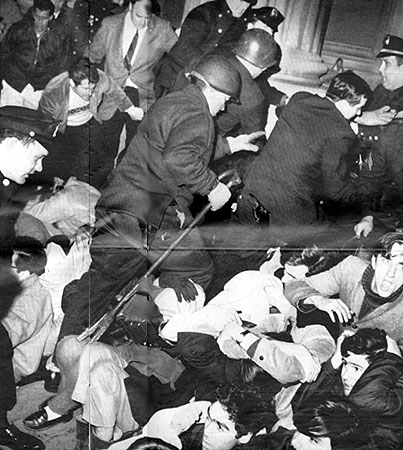
Police brought in to break up the student takeover of the campus and buildings
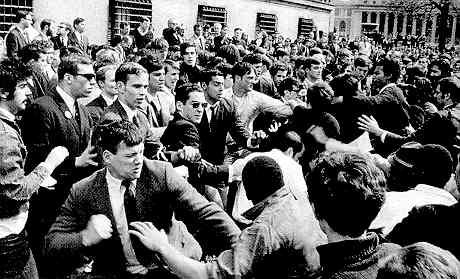
2000 student
counter-demonstrators
taking on the SDS
("Students for a Democratic Society") radicals
With Columbia University
students having taken over the university,
a professor conducts outdoors
class
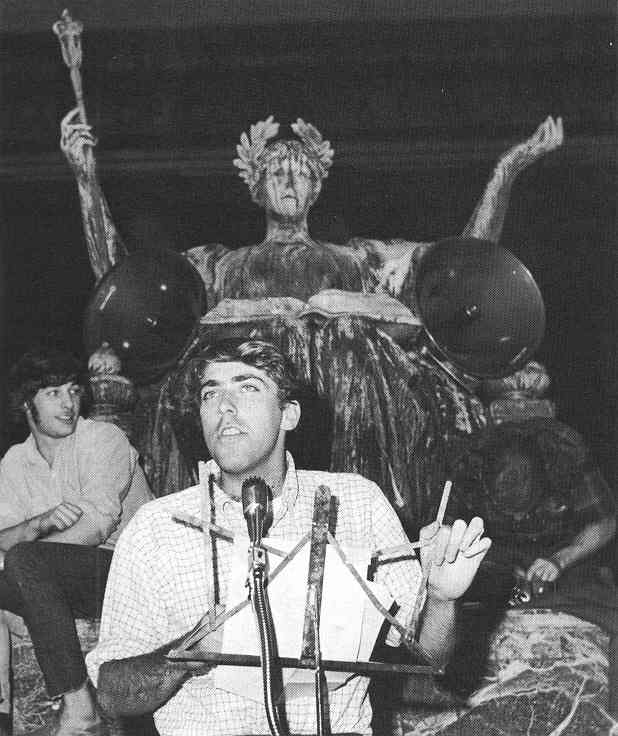
Columbia University strike leader Mark Rudd in May calling for demonstrations to continue into the summer
The sad Poor People's March on Washington (May-June)
| Dr.
King, not at all happy about how the Black Panther Movement had taken
over the civil rights movement he had so carefully started, had been
slowly refocusing his activities less on the matter of racism and more
and more on the matter of advancing the cause of America’s poor … Black
or White. Thus he had planned a huge Poor-People’s March on
Washington to begin in May – participants drawn from the Black
community’s urban poor to the Appalachian Mountains' communities of
poor Whites. They would occupy tents placed in the DC mall – like
the 1932 Bonus Army … but hopefully without the resistance from the DC
police that the 1932 event provoked. The hope was to get Congress
to take greater action in the interests of America’s poor, White or
Black. In fact the Sunday before he was assassinated, in his last
sermon (preached to a crowd at the DC’s National Cathedral) he made
clear how action on behalf of the poor was so vital to the nation …
because it was providing a sad excuse for the kind of racism (implying
both Black and White) that he found so tragic. But with the racist bullet that killed Dr. King, it appeared that his new broader civil rights plan had been effectively terminated. But it was decided to go ahead with the March … in part to honor Dr. King as much as to plead for Congressional action on behalf of the poor. But the event, which took place from mid-May to the end of June proved to be mostly a sad display of what the loss of Dr. King had meant to the civil rights movement … and to the deep resistance in Congress to any kind of Socialist programming demanded of the Federal government. Ultimately a spirit of tension, disappointment, and failure set in among the residents of "Resurrection City" (the mall's tent city) … and participants began to withdraw. And the constant rains that fell that June – and the deep mud they lived with – did not help matters any. Ultimately the event shut down … not sure that it had achieved any good purpose at all. |
In tribute to King, a “Poor People’s March” on Washington he had planned for that summer went ahead in June as scheduled … though it sadly turned into a muddy mess when it rained every day. Spirits were way down, especially when the effort seemed to produce no new advances in social or cultural programming
"Resurrection City": A muddy encampment on the Washington Mall during the Poor People's March - May 1968
The Boomer anti-War / anti-Racism / anti-? Protests
An anti-war protest in San Francisco - 1968
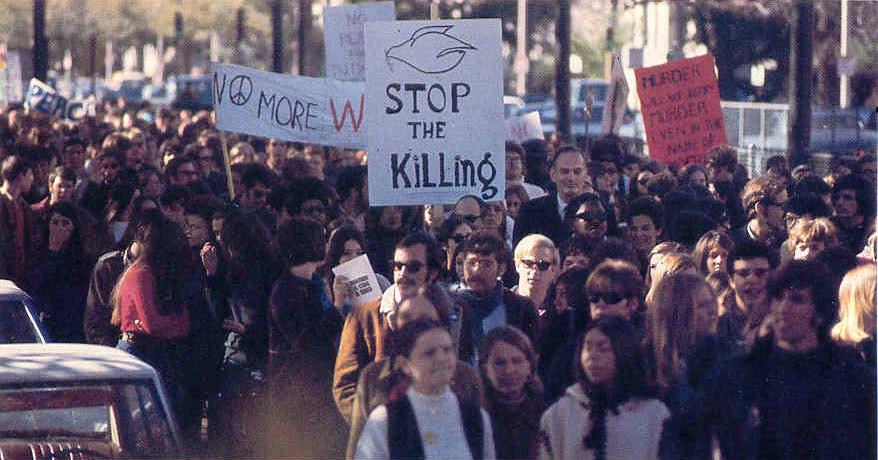
Fr. Philip Berrigan (center),
his brother Fr. Daniel Berrigan (right) and others of
the "Catonsville
Nine" watch draft files from the
Catonsville, Maryland,
Selective Service Office being burned - May 17,
1968
| Partly,
this demoralized spirit was inspired also by the assassination of yet
another American leader … Bobby Kennedy (JFK’s brother) – the
Democratic Party’s most likely candidate for the coming November
elections … and the individual most likely to have been the next
American President. He was shot exiting a political rally of his
supporters by a young Palestinian-American angry about American support
of Israel. But such vengeance served no one. Once again, America was shocked to the extreme. |
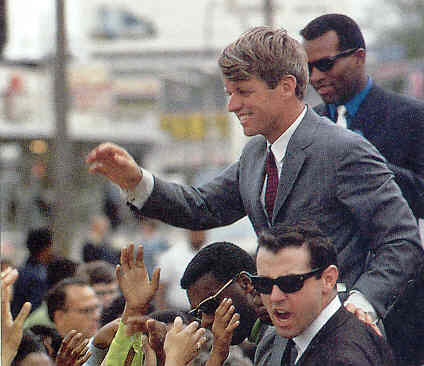
Bobby Kennedy stumping for
the Democratic Party presidential nomination - 1968
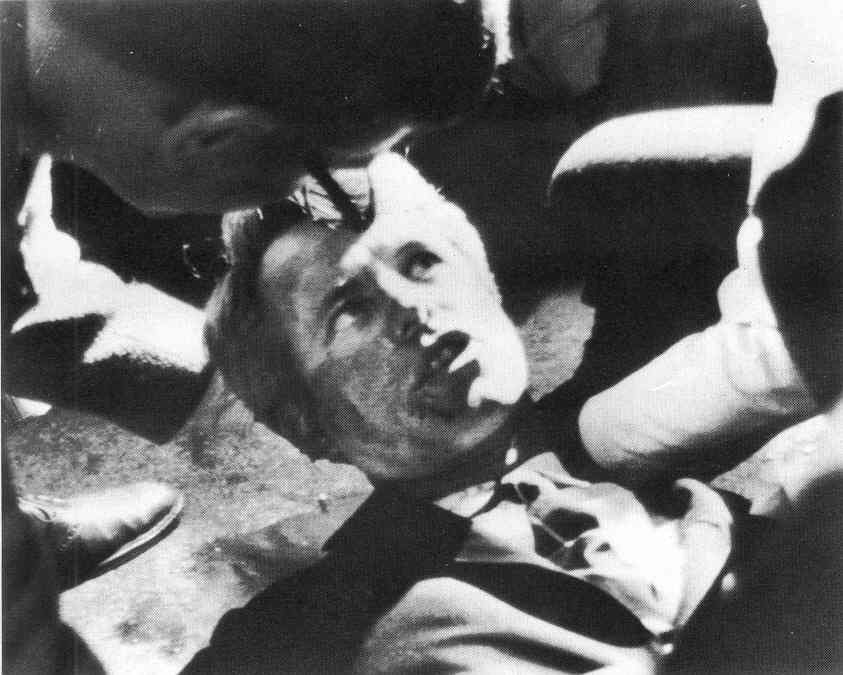
Bobby Kennedy shot at the
Ambassador Hotel in Los Angeles
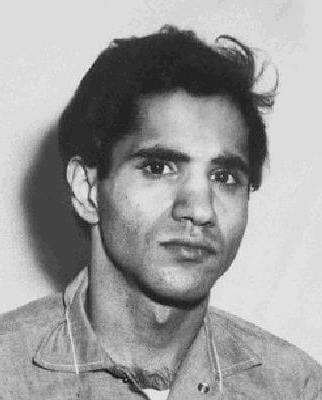
|
Sirhan Sirhan, was of a Palestinian Christian family that came to America when he was 12. He was angry at Kennedy's support of the decision to send 50 bombers to the Israeli air force (as a child, he had witnessed an Israeli tank run over his older brother ... and was very bitter towards Israel as a result) |
The Crazy Democratic National Convention - August
| Then
when the Democratic Party gathered in Chicago to choose a presidential
candidate, the event was accompanied by the mass assembly of young
American protesters … protesting the Vietnam war, protesting racism,
protesting anything about America they could find grounds to
protest. The behavior of the Chicago police sent by Mayor Richard
Daley was even worse, attacking not only protesters but, in the
surrounding mayhem, also delegates simply trying to attend the
event. And a very loud, foul-mouthed Daley shouting at the
speaker made the event even uglier. All across America TV viewers were watching the appalling site. What was happening to America? Nonetheless, the Democrats went on to choose Johnson’s Vice President Hubert Humphrey as their presidential candidate. His rather scholarly personality was believed to be just the calming influence to get the country settled back down again. |
Anti-war demonstrators gathering
before the Democratic National Convention in Chicago -
August 1968
Pigasus, the Yippie presidential
nominee seized by Chicago police prior to the opening of
the Democratic National Convention - August 1968
Protesters hurling back tear
gas at the Chicago Police - August 28, 1968.
Then the police seem to "lose it" and themselves turn
riotous.
The Chicago Police charging
the demonstrators at the Grant Park flagpole - August 28, 1968

Chicago policeman macing
a press photographer
after having maced the woman
to the left outside the convention hall - August 1968
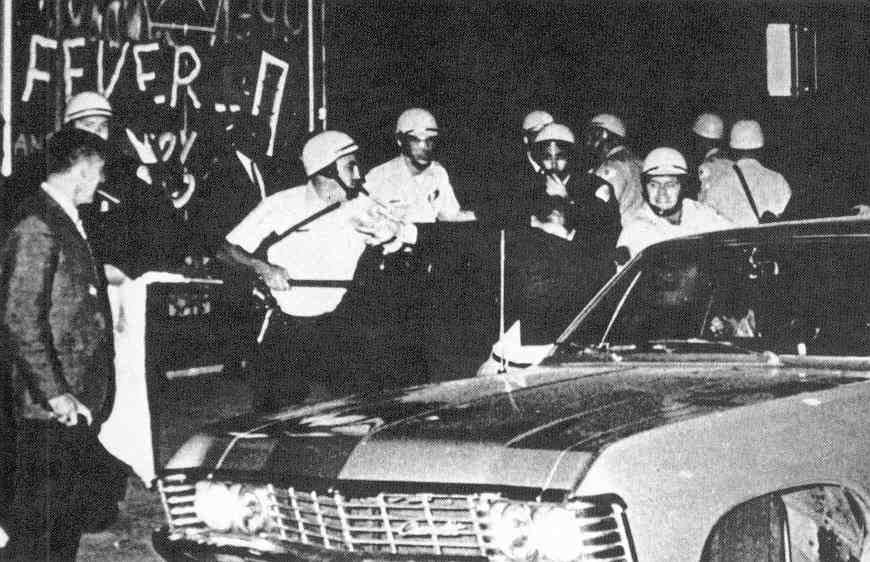
Chicago police attacking
a newsman who had just complained about their treatment of
some young people in a car - August 1968
John Evans of CBS News, himself
wounded by rioting Chicago police,
interviews another victim - 1968
Senator Abraham Ribicoff
and Chicago Mayor Daley squaring off at the Democratic National Convention about
the tactics of the Chicago police (Daley's shouted response:
"F... you, you Jew son of a b....")
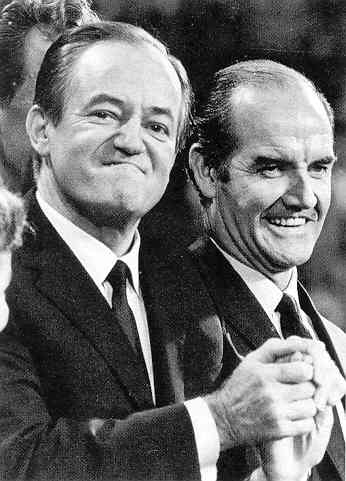
Hubert H. Humphrey and his
defeated rival George McGovern at the Democratic National
Convention
September 7, 1968 - about 400 feminists gather in Atlantic City to protest the Miss America Pageant, trashing bras, high heels, cosmetics and briefly putting a fire to the trash bin (but quickly put out by the police) ... starting the talk about feminist "bra burning"
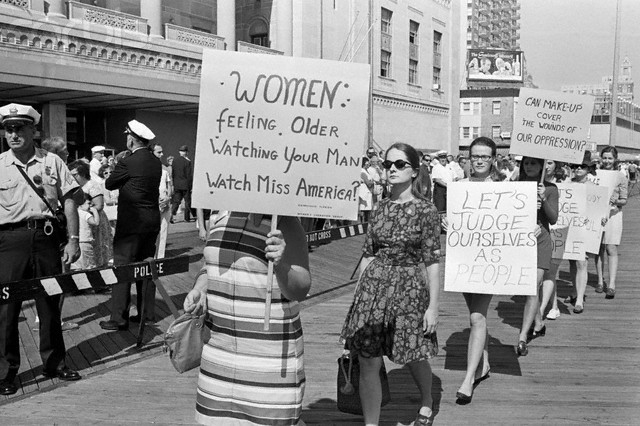
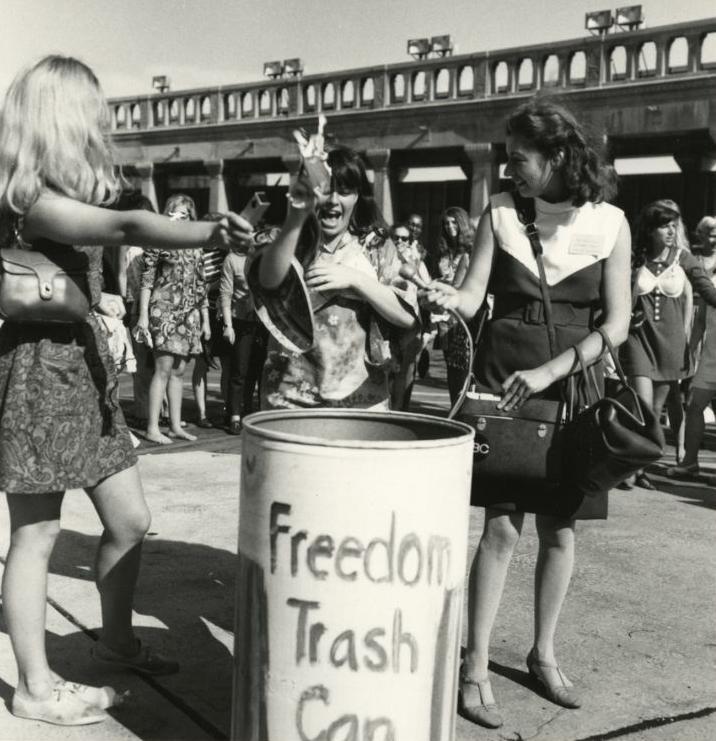
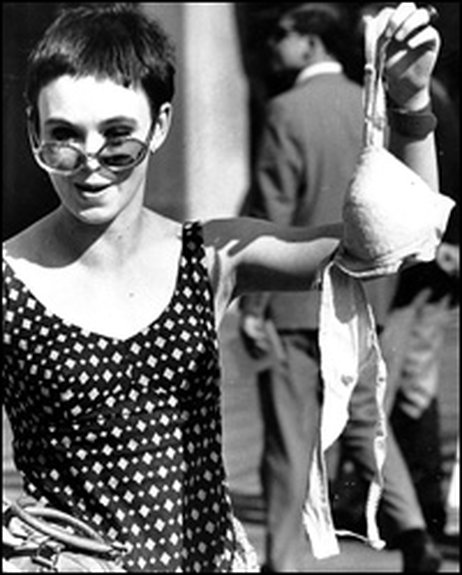
The idea catches hold and grows as a sign of their "freeing" themselves from society's expectations of them as women
A demonstrator removes her
brassiere during an anti-bra protest outside a San Francisco department store
America's November Elections The Republican National Convention in Miami had been a much quieter affair, the Republicans once again choosing Nixon … and bringing Maryland Governor Spiro Agnew on board as his Vice President, someone who had gained national attention when he came down hard on Black protesters and spared Baltimore and the rest of the state the agony inflicted by Black Power toughs following the King assassination. But there was a third candidate running, White racist Alabama Governor George Wallace1 – expected to cut deeply into the Democratic Party's "Solid South" support … which is exactly what he did, giving Nixon 43.4 percent of the vote, Humphrey 42.7 percent and Wallace 13.5 percent, ruining the expectations of the Democrats for an easy win in the elections. But in any case, Nixon was able to get a strong majority in the electoral college vote (the one that actually counts), Nixon with 302 votes, Humphrey with 191 votes, and Wallace with 46 votes. 1The world of American politics is truly amazing. When Wallace saw Blacks finally eligible to vote, as an ongoing governor of Alabama, he became a major supporter of Black economic and educational development … and became well supported by Black voters! |
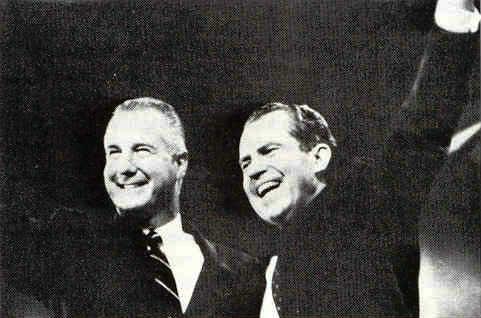
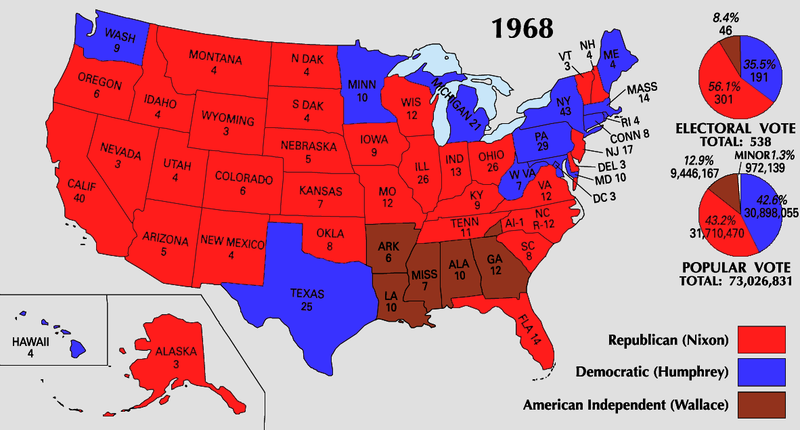
STUDENT REBELLION IN WEST GERMANY |
| The
Socialist German Students' Union (SDS) had been cut off from its
sponsoring political party, the Social Democratic Party (SPD) of West
Germany in 1961. Since 1954, when the West German Federal
Government had joined NATO, the SPD had moved politically closer to the
Center … while the SDS moved even further to the Left (it was
discovered years later that the student organization had been receiving
considerable support from the East German Communist government). In the mid-1960s, the SDS became inspired greatly by America’s Black Panthers with their "burn baby, burn" mentality – plus the campus protests of America’s Student for a Democratic Society (the American SDS). The German SDS mood of political protest thus deepened even further … finding cause finally in June of 1967 to go beyond its broad "anti-Fascist" campaign – and protest specifically against the visit to Germany of the Iranian Shah. In the confrontation with the police over the matter, one person was killed. Now the German SDS became even more radical … especially the group headed by Rudi Dutschke – who took the lead in a number of protests in Germany against American imperialism in Vietnam … coinciding with the huge anti-war protest march on the American Pentagon in October of 1967. The following year, returning from events developing in Czechoslovakia, he was nearly killed in an assassination attempt. After that (the end of the 1960s), the more radical elements of the SDS came under the leadership of Andreas Baader and Ulrike Meinhof … forming a group that came to be known as the Red Army Faction – but also as the Baader-Meinhof Gang … a group conducting bank robberies, bombings, assassinations, and shootouts with the police (especially intense during the 1970s). |
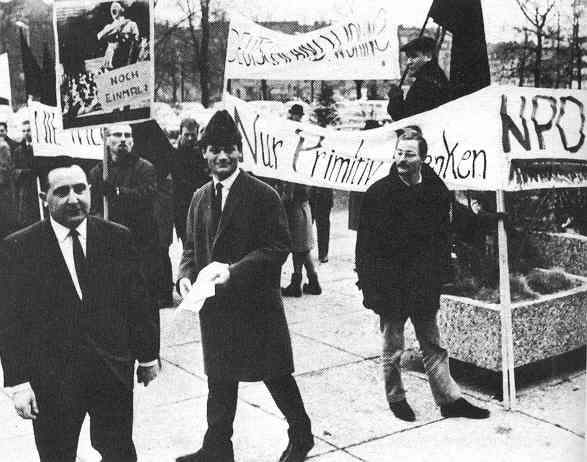
German university students
protesting a meeting in Nuremberg
of the neo-Nazi German Democratic
Party
THE "EVENTS OF MAY" IN FRANCE |
| Developments
along a similar line began to unfold in France – but becoming more
violent … much more violent. These were protests by university
students which broke out in Paris in May against academic bureaucracy,
capitalism, the consumer culture, American imperialism in Vietnam … or
against most anything identified with the adult world. The situation had been slowly building for a couple of months. But on May 2nd when the Sorbonne University was shut down, the situation became explosive. Four days later, some 20,000 students and teachers marched towards the Sorbonne to protest the closing … and were met by Paris police. Things got very ugly at that point. But the protest merely widened the next day and those following … and by May 13th, some million protesters filled the streets of Paris. Then they were joined by striking workers – although their cause was simply the demand for better working conditions. Nonetheless, with both students and workers in full protest across France, it appeared that the country was facing something that looked like an actual civil war. This in turn produced political turmoil at the highest level of French politics. The Socialists demanded the formation of a new government … and at the end of May de Gaulle responded by slipping quietly out of Paris and heading to Germany "to avoid bloodshed." At the same time some half a million protesters, led by the workers' union (the CGT), marched through Paris … calling for de Gaulle’s resignation. Finally a call from de Gaulle for new national elections, plus the rumor of government military and tanks forming around Paris, and then the march in Paris of some 800,000 of de Gaulle’s supporters led the Communists to agree to the elections and the students to call off further protests. Most surprisingly, the elections in June resulted in a huge Gaullist electoral victory … and a huge reduction in size of the Communist and Socialist representation in the National Assembly. There would be another student protest in Paris's Latin Quarter on the country’s national holiday, Bastille Day (July 14th) – rather harshly put down by the Paris police. And that would bring the student’s revolutionary mood pretty much to a close.2 2But such events went on to inspire John Lennon to write the song (and the Beatles' album) Revolution released in August of 1968. 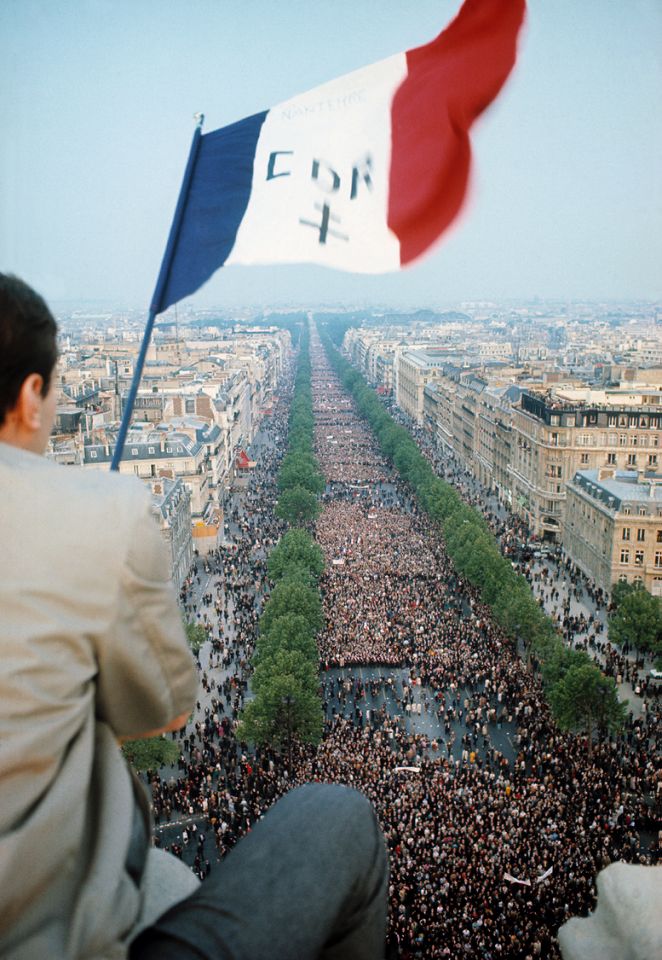 May 1968 - It all begins as a mass demonstration in favor of ... social reform?
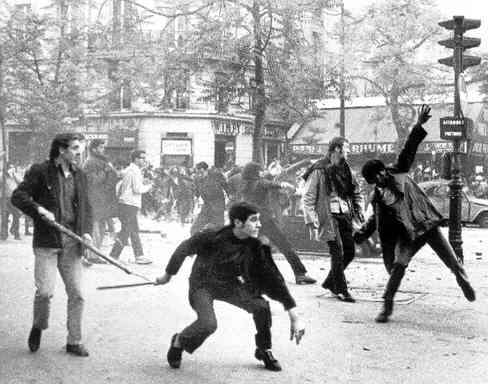
 Paris police storming student
barricades in the Latin Quarter French President Charles
de Gaulle at a press conference - 1968. He promised social reforms ... to meet some of the demands of the rioting youth. But ultimately his idea of "social reforms" was to increase his own power as French President
A Czech youth challenging
an invading Soviet tank crew The forceful end of the "Prague
Spring" - August 21, 1968
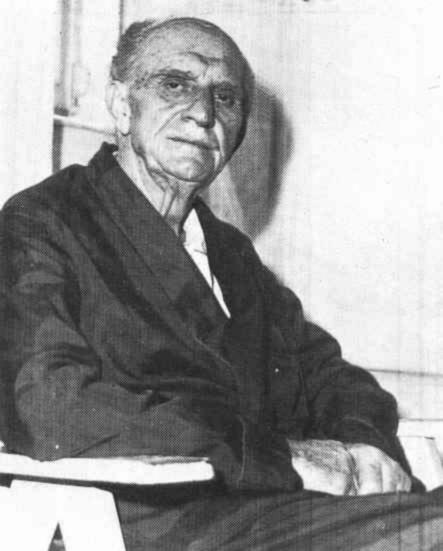
Greek Prime Minister George
Papandreou resting at a military hospital following a military coup
and his arrest by a right-wing junta in April 1968 (in which the US was adjudged
by many
to be in complicity) Greek King Constantine and
military leaders behind the coup which overthrew the Papandreo
government (the king later broke with
the junta and failed in an attempted countercoup)  Go on to the next section: Closing the Turbulent '60s
 |

